|
|
Post by Prince Hal on Jul 11, 2020 18:59:12 GMT -5
"After nearly 3 years of this title, Roy... only covered 2 months of history."
Call it 30 issues per two months and the Normandy invasion would have been a great read in A-SS #180 or so, sometime in 1999.
|
|
|
|
Post by codystarbuck on Jul 11, 2020 20:13:43 GMT -5
"After nearly 3 years of this title, Roy... only covered 2 months of history." Call it 30 issues per two months and the Normandy invasion would have been a great read in A-SS #180 or so, sometime in 1999. Except, after 60+, I don't think he ever got to 1943. |
|
|
|
Post by donaldg on Jul 11, 2020 20:43:14 GMT -5
"After nearly 3 years of this title, Roy... only covered 2 months of history." Call it 30 issues per two months and the Normandy invasion would have been a great read in A-SS #180 or so, sometime in 1999. Except, after 60+, I don't think he ever got to 1943. Roy's rule of thumb when writing this title, as mentioned in at least one letter column, was that one year of publication time (12 issues) chronicled one month in the lives of the team. The title only got up to April 1942 when Crisis hit. |
|
|
|
Post by Prince Hal on Jul 11, 2020 21:08:43 GMT -5
"After nearly 3 years of this title, Roy... only covered 2 months of history." Call it 30 issues per two months and the Normandy invasion would have been a great read in A-SS #180 or so, sometime in 1999. Except, after 60+, I don't think he ever got to 1943. Yikes. Good thing Roy never wrote a book set during the Hundred Years War. |
|
|
|
Post by dbutler69 on Jul 13, 2020 9:18:44 GMT -5
It always bothered me that Wing wasn't considered a Soldier of Victory. Of course, if they were called the Eight Soldiers of Victory, we'd lost that oh-so-important alliteration.
Yes, Roy did recycle perhaps too many Golden Age stories in this series. Perhaps my biggest problem with that, though, is that the stories seem rushed, as he's usually trying to compress a story of something like 62 pages into something like 25 pages. Not a good path to success.
|
|
|
|
Post by Prince Hal on Jul 13, 2020 9:35:49 GMT -5
It always bothered me that Wing wasn't considered a Soldier of Victory. Of course, if they were called the Eight Soldiers of Victory, we'd lost that oh-so-important alliteration. Yes, Roy did recycle perhaps too many Golden Age stories in this series. Perhaps my biggest problem with that, though, is that the stories seem rushed, as he's usually trying to compress a story of something like 62 pages into something like 25 pages. Not a good path to success. And that's what made this cover kind of a dodge, since everybody who had been a fan knew that Wing was always with the Crimson Avenger. He may have been "unofficial," but he wasn't "unknown."  |
|
|
|
Post by codystarbuck on Jul 19, 2020 17:07:24 GMT -5
All-Star Squadron #30 The Black Dragon Society doing what many readers wanted to do, to Johnny Thunder (Thunderbolt was okay, though). Creative Team: Roy Thomas-writer/editor, Mike Machlan-pencils & inks, Richard Howell-pencils, Sam De La Rosa-inks, Cody Weiss-letters, Gene D'Angelo-colors. Synopsis: Wonder Woman arrives at the Perisphere, late at night and finds Liberty Belle working. The boys are off feeding their face; typical men! Belle (and Roy) laugh at the notion of Wonder Woman as the "secretary" of the Justice Society... 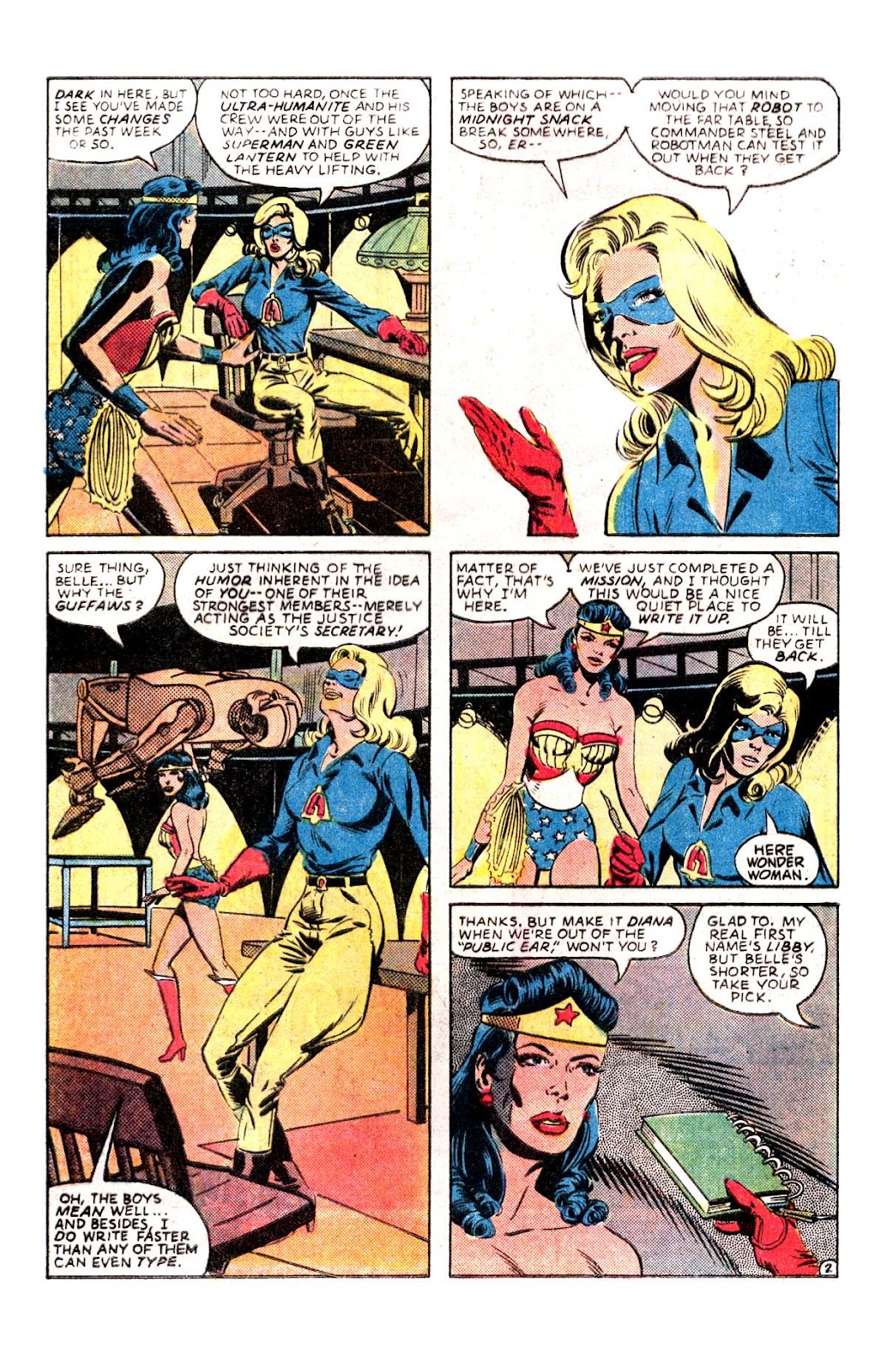 Wonder Woman records a meeting of the JSA, where Hawkman briefed them on the Black Dragon Society. he is interrupted by Major McNichols, their military liason, with news that several inventors have gone missing and the BDS is suspected... 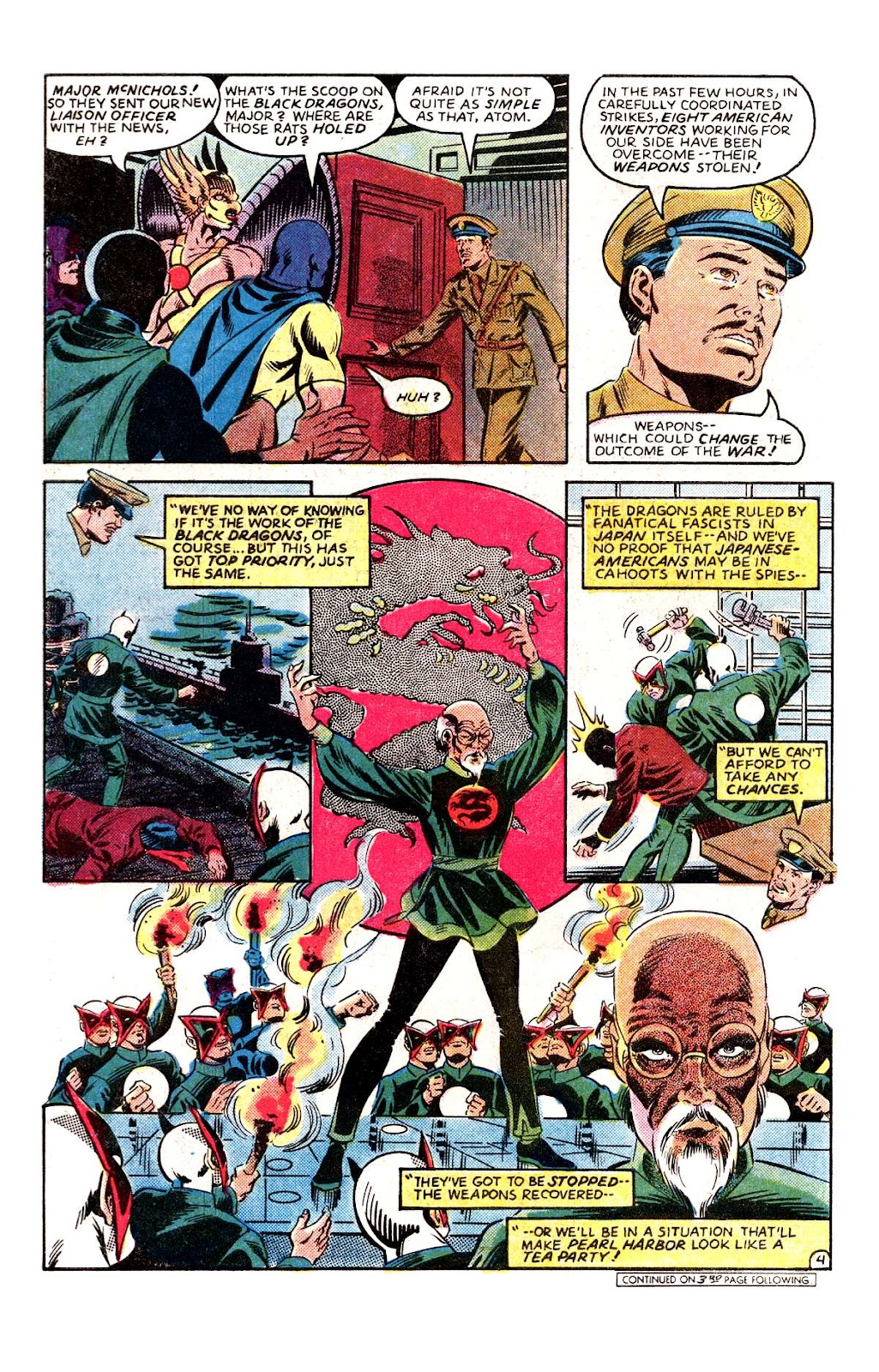 Wonder Woman gets left behind while the boys go out to measure their genitals. This being Roy doing the JSA, everyone has to split up, to maintain the cliche. We start with Hawkman, who heads to one of the many European castles that dot the American landscape, where Japanese soldiers prepare a giant propeller ship, while looking like fugitives from a Wally Wood comic... 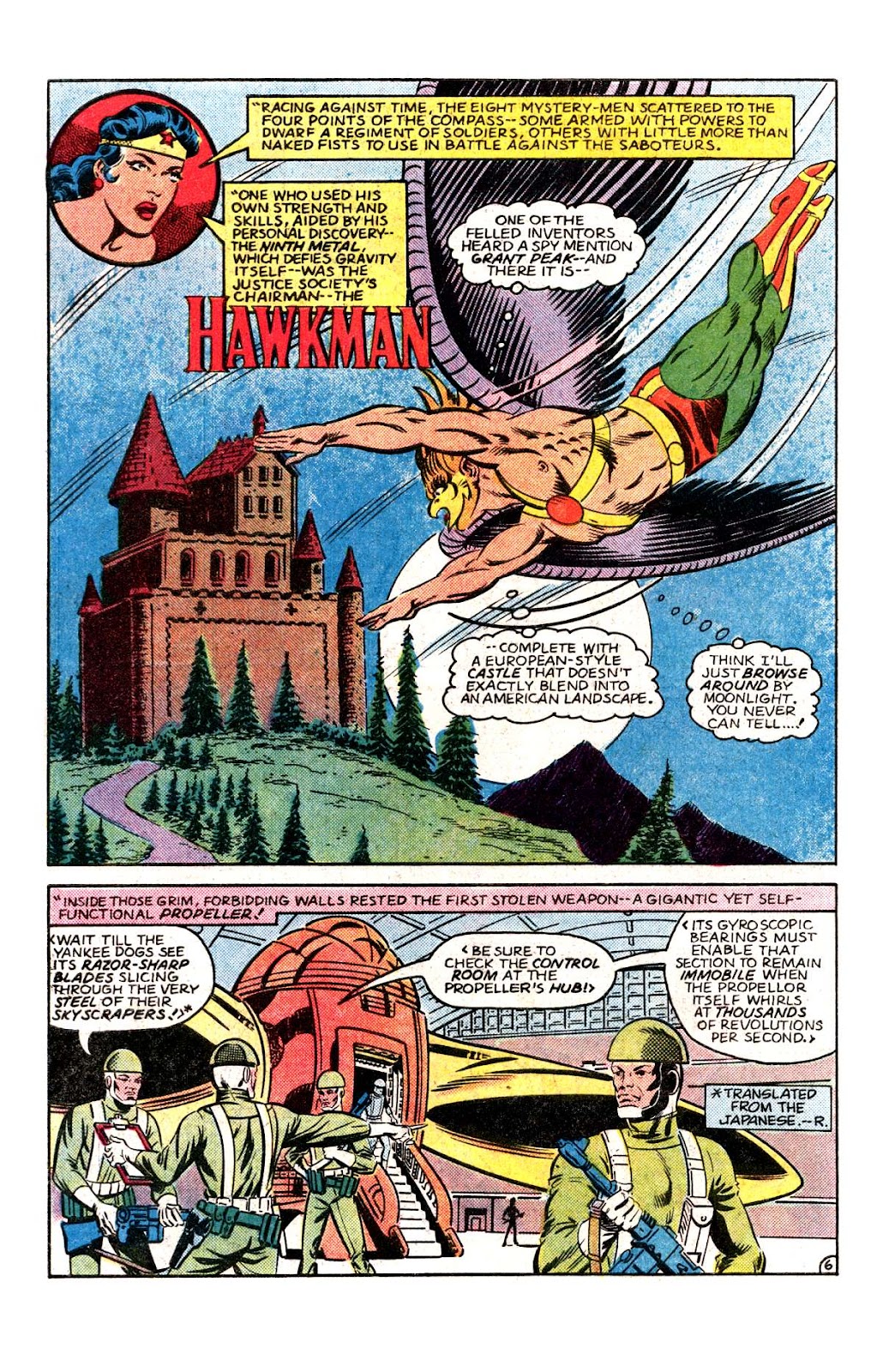 Inside, Hawks finds BDS members in uniform, which is a cross between Hydra and Batwoman. He sneaks around (no mean feat, with the huge wings) and finds the blueprints for the machine; but is discovered and the Japanese spies fire German Lugers at him. I think they meant for it to be the Japanese Nambu pistol.... 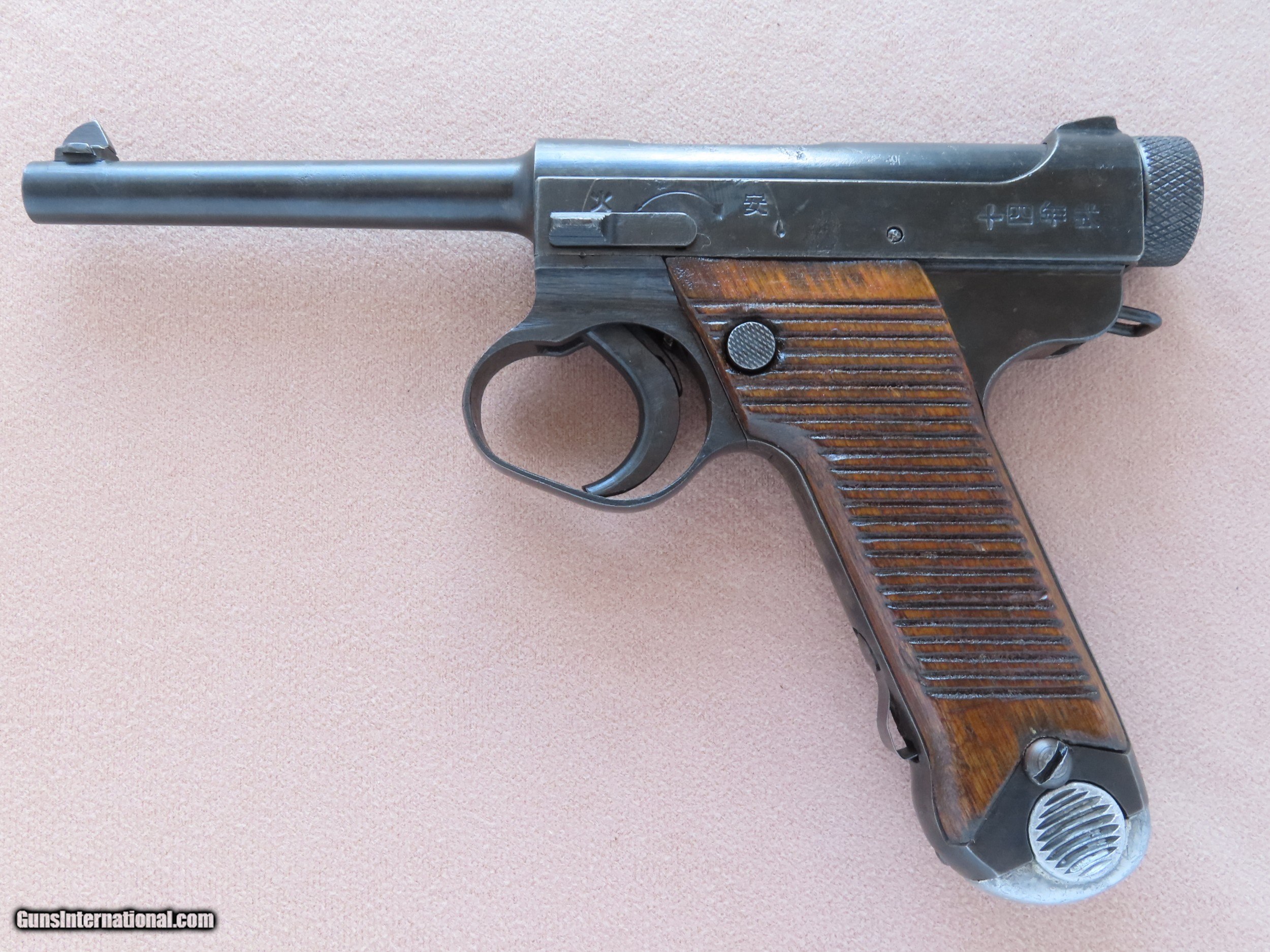 but, it is drawn with a toggle bolt, like the Luger P-08 The Japanese also carry what look like Thompson submachine guns, when Japan had the Nambu Type 100...  Regardless, they fight and Hawks goes down, but, a bullet to the head is too good for the Yankee dog and he is ordered to be tied to the prop... 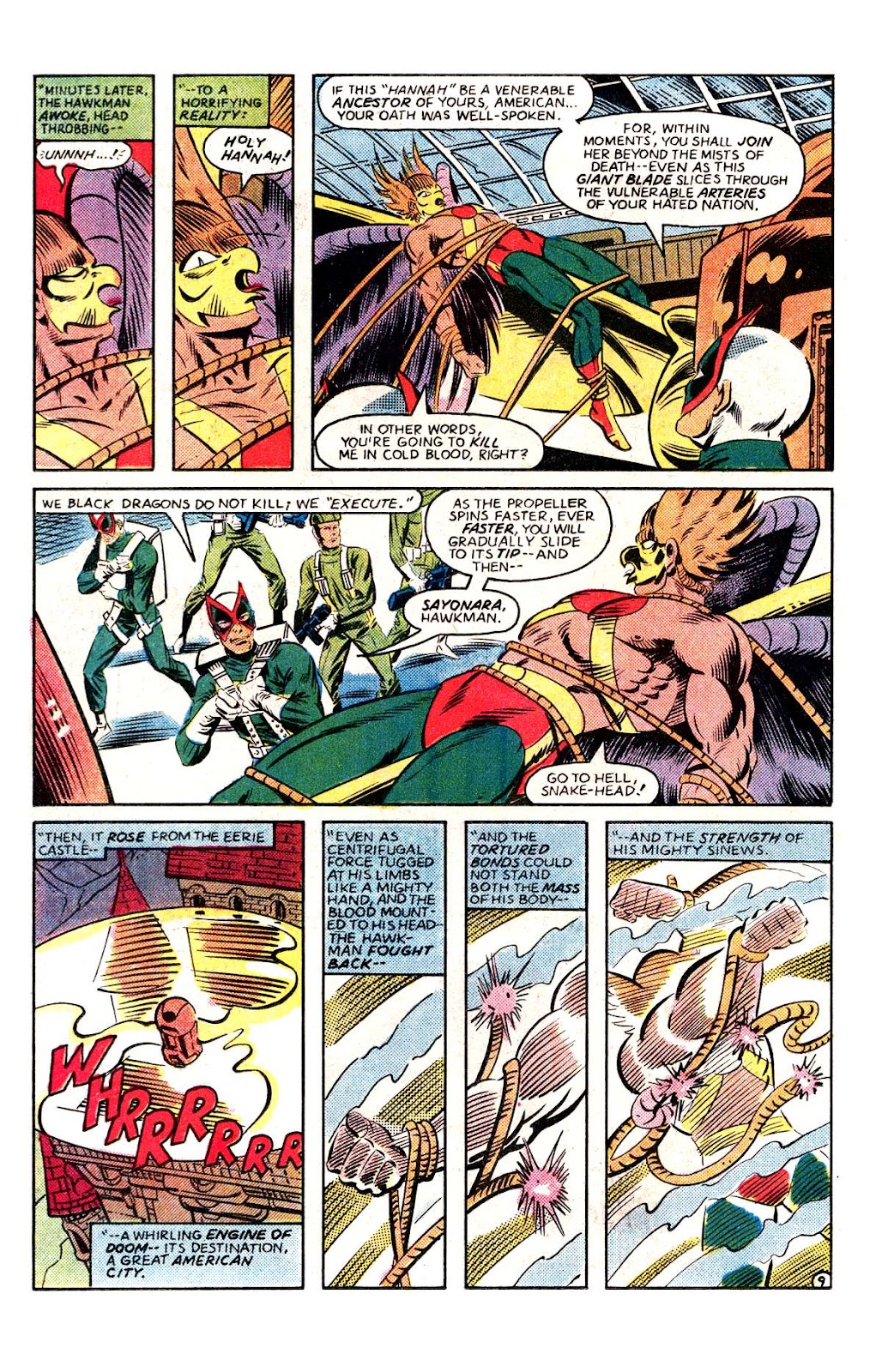 ...because, why do anything the easy and efficient way, when you can be over-the-top? Hawks gets thrown off, recovers, stops the machine from bombing a city, then breaks inside, disrupts thing s and crashes it into a tower of the castle. The other JSAers stop similar war machines... 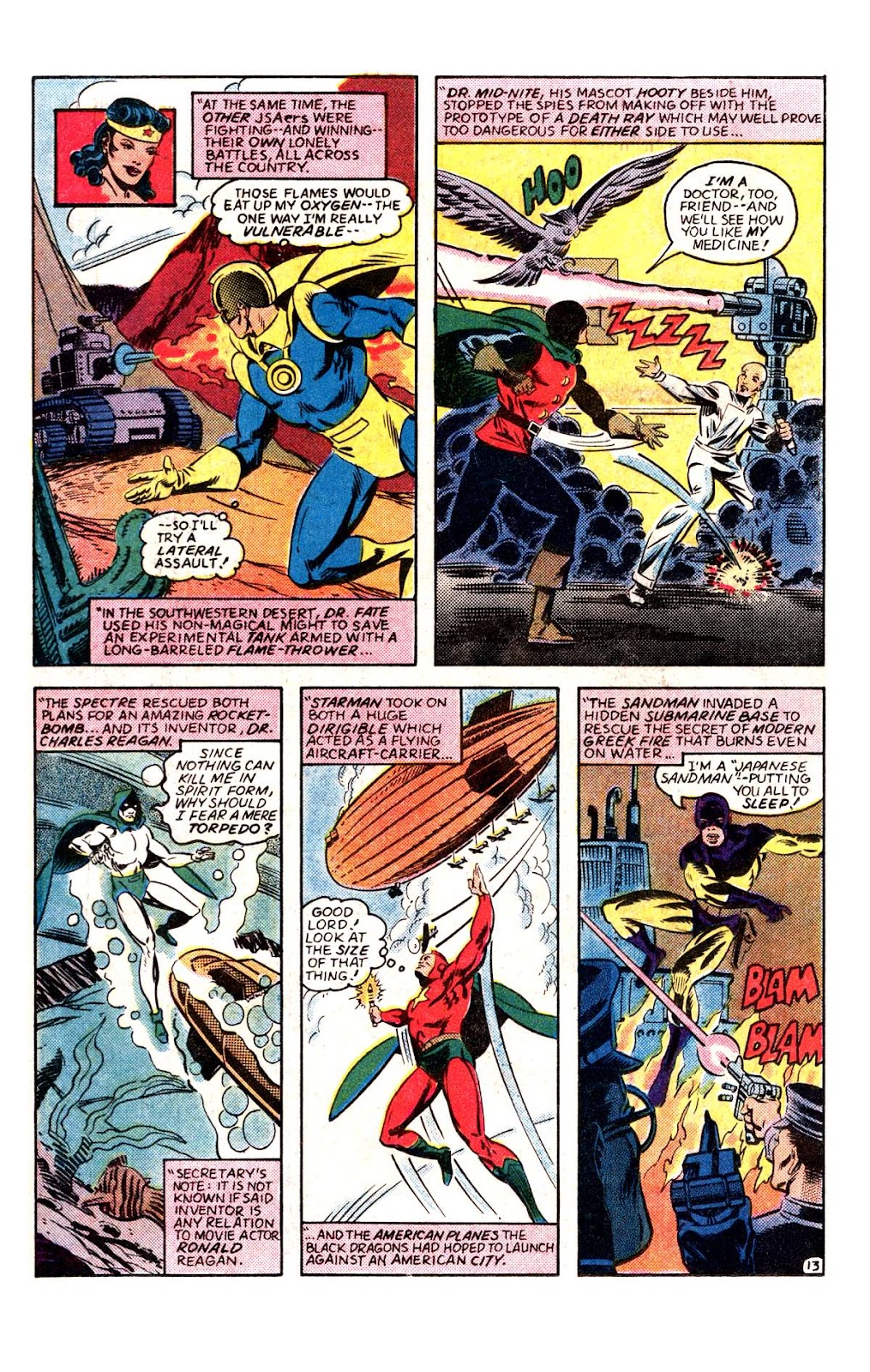 Atom goes to San Francisco to locate a high explosive that was stolen, with few leads until Japanese American stumbles upon him and leads him to the restaurant that is acting as a front for the group.  They bust up the joint and Atom catches a glass ball filled with the explosive, before it hits. Roy doesn't do the obvious and the helpful Nissei is a hero. Johnny Thunder gets caught because he orders T-Bolt to save a factory, as he is captured. He's about to get the chop (or knife) when T-Bolt bends the rules a bit and brings in the JSA, since he can't fight directly, without orders (didn't know he was under UN command). They go around busting heads... 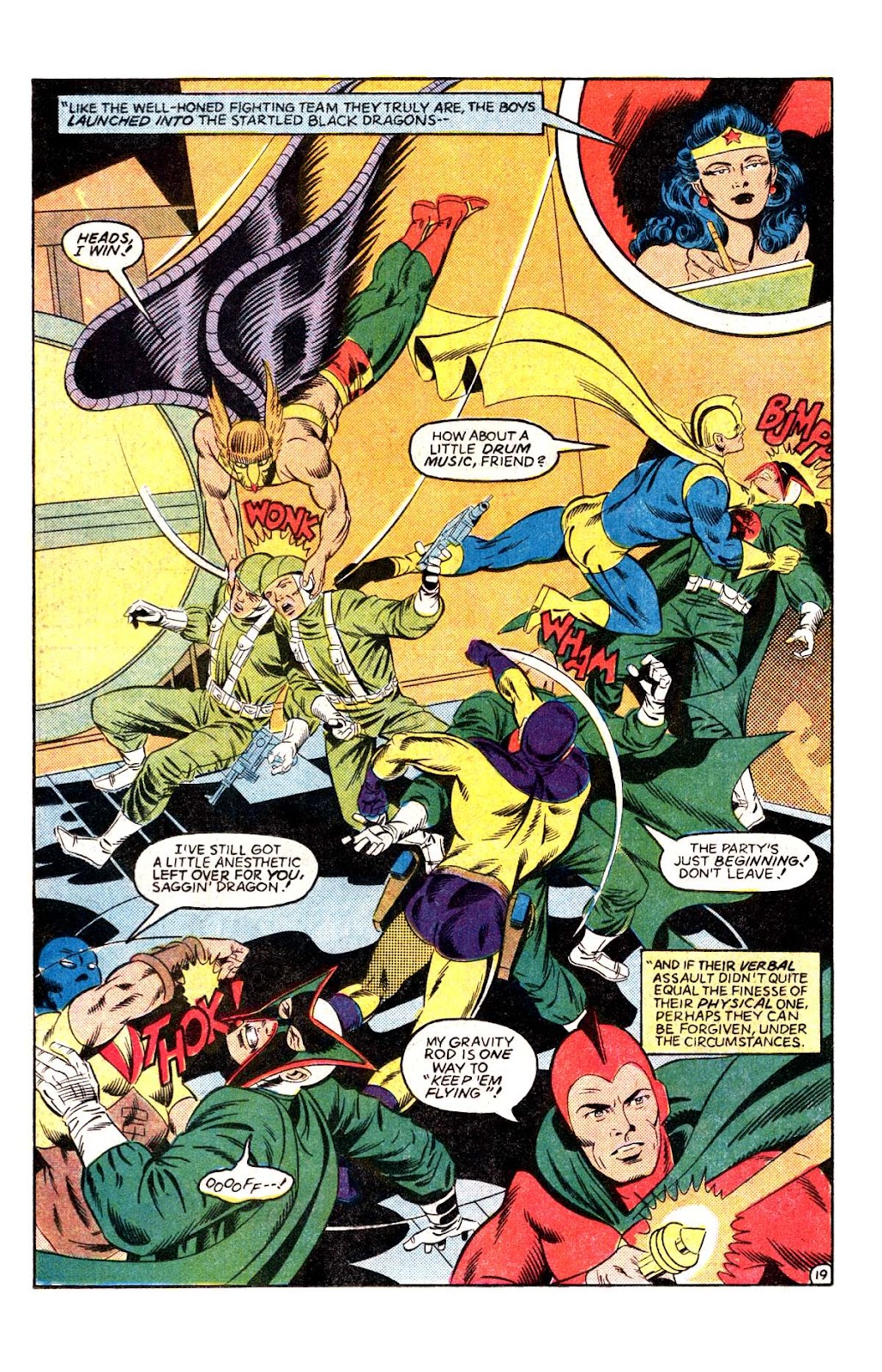 Johnny is freed, decks the leader. WW wraps up her record, the Roy makes a statement about the anti-Japanese sentiment, alluding to, but never outright stating it was built on a foundation of racism. Belle gives a positive endorsement of the country, then Roy finishes with FDR signing Executive Order 9066, which led to the internment of American citizens, without due process of law. Thoughts: Kind of a let down, actually. This is a pretty cliched All-Star Comics plot, for something that was far more serious. Plus, it loses the chance to do something a bit more interesting, ala G-Men vs the Black Dragon, the Republic serial that helped inspire the idea (along with Dr Daka, the villain from the first Batman movie serial). I think Roy's nostalgia for the original All-Star stories clouds his judgement here and he was the editor, so no one could say boo to him about it. Once again, I have to agree with Jim Shooter that a writer should not be his own editor, as there is no neutral observer. Also, I don't think the main audience for this series was really interested in capturing the look of Golden Age comics as much as Roy was. I think Howell was trying to draw relatively accurate Japanese paratroop-style uniforms and equipment...  ..but, as I said, it looks a bit more like Wally Wood material from THUNDER Agents or Total War/MARS Patrol. Historical Notes: So, we covered the Black Dragon Society earlier on, plus the internment of the Japanese. I chuckled at some of the wonder weapons. We had flame throwing tanks and used them during the island hopping campaign, in the Pacific, and the British also had their own version (Germans too). the flying prop is, basically, a helicopter, which had already been developed, though taken to an extreme. however, real helicopter rotor blades work a bit differently than an airplane prop or ship's screw. Those propel air or water to produce movement, while the rotors also act as a wing structure, to capture the lifting forces. Also, helicopters have a tail rotor or other set up to counteract the centrifugal motion created by the main rotors. When disabled, a helicopter will spin around the axis of the rotor shaft. Roy gives it some kind of gyroscopic feature. Death rays were science fiction stuff, but, we did develop lasers and masers from these concepts, though they aren't quite the same kinds of weapons. The rocket bomb is just a guided missile, which was in experimental stages. Greek Fire was an old concept, which helped inspire things like napalm, which is a flammable jelly that burns with intense heat. The miracle explosive is pretty much nitro glycerin. The most ridiculous, as a futuristic wonder weapon, is the dirigible aircraft carrier. The US Navy already had one, the USS Los Angeles, and had lost two other, The USS Akron and USS Macon, at sea, in 1933 and 1935 (respectively) Each could carry Sparrowhawk fighter/spotter planes in a belly hangar, launch them and recover them, in flight. the Los Angeles carried out the initial experiments and could hold 3 aircraft; the Akron and Macon could hold 5...  The Akron went down in a storm and lost all but 3 of the crew, because they carried no floatation devices or life rafts, to reduce weight. The Macon was refitted with life saving gear and only lost 2 of the crew, when it went down. After the loss of it, the Los Angeles was grounded. however, the US Navy had an extensive fleet of blimps during the war, which acted as convoy escort and as anti-submarine platforms. The N-class blimps had a crew of 21, compared to over 80 for the dirigibles, and the modern ships, like the Goodyear blimp. My father told me, when he was a boy, during the war, he witnessed a flight of blimps go overhead, probably transiting from the Goodyear factory in Akron, to the West Coast. Now, I said I was going to cover the war month by month, since Roy never gets out of 1942. We will start with February, since that is where he is stuck. We have already discussed the fire and capsizing of the Normandie, during the Ultra-Humanite story that introduced Infinity, Inc. We also covered "The Battle of Los Angeles," and the fall of Singapore. the bombing of Darwin, and MacArthur being ordered out of the Philippines. So, we will turn to a few military engagements and a human tragedy. First is Operation Cerberus. The Germans had to Scharnhorst class battleships and a heavy cruiser in Brest, in southern France, being refitted. Hitler wanted them returned to northern ports to guard against the British taking further action in Norway, after previous failure at Trondheim. The quickest route was through the English Channel, which was heavily patrolled; however, it allowed for Luftwaffe air cover from the land. the three ships, plus 6 destroyers, 14 torpedo boats and 26 E Boats sailed on February 11 and escaped detection all the way to Dover. The British had planed for such an event; but, combined operations were still a new thing and delays resulted in failure. The british sent Swordfish torpedo bombers to engage, but, their fighter escort was late in meeting up with them and they fell prey to the Luftwaffe. Coastal guns at Dover tried engaging, but visibility was low, resulting in the reliance on radar to gage where the shots were falling and the Germans slipped out of range because they couldn't adjust fire quickly enough. Torpedo boats were dispatched but encountered the E Boats, Air attacks were limited by same visibility. Ships on gunnery exercises were dispatched to intercept; but, the flotilla moved fast than expected and they missed them. Heavy bobmbers, due to visibility, also failed to sink any of the ships. They did suffer damage in minefields, though not enough to put them out of action. In the end, the operation to stop them was a failure; but, it proved a moot point. The ships were effectively useless, as they couldn't leave their harbor without being attacked from the air and could no longer engage in convoy raiding. In the end, Hitler's decision to defend against a never-to-materialize Norway invasion took ships out of the battle for the Atlantic. In the China-Burma-India theater, the Battle of Sittang Bridge occurred, between Feb 19-23. The British were in retreat from the Japanese and suffered badly at Battle of Bilin River and were retreating across the Sittang Bridge, a heavy rail bridge across the river of the same name. The Japanese were aggressively advancing to cut them off. The British forces consisted of the 17th Indian Army Division, which was equipped with outdated weapons and was low on water. They were under constant attack from Japanese aircraft and were forced to abandon vehicles and heavy equipment, taking refuge on a rubber plantation. The Indian soldiers foguth off a Japanese attack. However, forces were split and cut off from the bridge. British command dispatched Gurkha units to secure the bridge from potential paratroop attack. Fighting was intense and hand-to-hand, at some stages. Finally, the British commander faced the decision to blow the bridge and halt the Japanese, or wait until his men were able to withdraw. he chose to blow the bridge, cutting off the remnants of the 17th. The survivors eventually crossed the river by swimming or raft. They were able to do so because the Japanese withdrew to find other crossings, as their goal was to take Rangoon, more than the destruction of the 17th. Our human tragedy occurred on February 24. On December 12, 1941, the motor vessel Sturma set sail from Romania, loaded with Jewish refugees from Palestine. Well, "set sail" is being kind. it attempted to leave port, with the blessing of the Axis-friendly Romanian government; but, could not start its engines after being towed out of the harbor and past mine fields. She was then left to drift through the night, as the crew tried to make repairs. The passengers included over 700 refugees, who had paid dearly for tickets and visas to Palestine. After failing to get the engines going, the ship radioed a distress and was met on the 13th by the Romanian tug. The tug crew refused to make repairs, unless paid, but the passengers had already been shorn of their money. They paid with rings and watches and the engines were started, but failed again by the 15th. They were towed to Istanbul, in neutral Turkey. The British were refusing to take the refugees, under the terms of the White Paper of 1939, limiting Jewish migration to Palestine. The Turks refused to allow the passengers to disembark. the british hard line stance was, in part, due to unrest in Palestine between Arabs and Jewish settlers. Food was running out and heavily rationed on the ship. The British eventually allowed a small group with expired visas to travel overland. Eventually they relented to letting children between the ages of 11 and 16 be issued visas; but, there was a dispute about transportation. Finally, on Feb 23, Turkish police boarded the boat (after first being blocked and callig in reinforcements) and let loose the anchor. The ship was left adrift, with signs hanging over the side, in English and Hebrew, saying "Save Us." On the 24th, an explosion tore through the ship and most drowned, as they were below decks when the ship began to sink. Some survivors floated on wreckage, but succumbed to injury and exposure. Only one man, 19 year-old David Stoliar, survived. Of the 791 believed lost, over 100 were children. For years the source of the explosion was a mystery, with some belief that they hit a mine. It was eventually revealed that it was torpedoed by the Soviet submarine Shch-213, which also sank a Turkish merchant ship. Lord Wedgewood condemned the British government's actions in the House of Lords and demanded that the League of Nations Mandate, over Palestine, be transferred to the USA. It was not. The US did not have clean hands in all of this, as in 1939 it had refused entry to a ship, MS St Louis, carrying more than 900 refugees, as did Cuba and Canada. In 1944, another Russian submarine torpedoed a Turkish ship carrying over 300 Jewish refugees, which was flying under joint Turkish and Red Cross flags. The ship was sunk by fire from the sub's deckgun, not torpedoes, meaning they were surfaced and could, theoretically, positively identify them. Finally, at the end of the month, an Allied naval force, under Dutch command, engaged the Japanese in the Battle of Java Sea, in an attempt to block the Japanese from landing at Java. the Japanese had already made landings in several islands of the Dutch East Indies, including Borneo and Sarawak. The Japanese hoped to gain the oil reserves present throughout the islands, to fuel their war machine and industrial economy. It would also aid in launching attacks on New Guinea and the Solomon Islands, there by cutting off Allied supply lines to Australia. The Japanese invasion force consisted of 2 heavy cruisers, 3 light cruisers and 14 destroyers, with much more firepower than Allied force of 2 heavy cruisers, 3 light cruisers and 9 destroyers. The 2 Allied cruisers could only mount 12 guns against 20 for the Japanese. The Allies tried to engage the invasion fleet, but had to fall back against superior firepower. they had air superiority in the day; but, communications were jammed and they only possessed one ship with radar. Engagements raged from about midday to midnight, with the HMS Exeter withdrawing due to damage to their boiler and a further sinking of the Electra, after it was abandoned, due to battle damage. The Japanese only withdrew one ship, due to damage. The remaining ships again encountered the Japanese and the fleet commander, Adm Karel Doorman, went down with the cruiser De Ruyter. The rest ran low on ammunition and fuel and disengaged. Further Allied ships were lost in separate engagements and only 4 of the 14 ships made it to safety, in Australia. The Japanese landed on Java on the 28 and fought the Dutch until March 9, when the Allies capitulated. They gained control of the food production resources of Java and controlled the world's 4th largest oil supply. Allied operation in SE Asia were at an end, for 1942. Japan controlled territory from the home islands to the Marianas and Gilbert Islands to the East, portions of the Solomons to the south, were consolidating control of the Philippines in the southwest and now had the Dutch East Indies in the East, plus control of Korea, Vietnam, Thailand, large portions of Burma, and much of Manchuria and portions of China. Only New guinea, Australia, New Zealand, and the Hebrides remained in Allied hands, in the South Pacific, plus the US bases at Midway and Hawaii. Midway would be seeing action in the near future. By March f 1942, Japan seemed invincible and Germany was doing pretty well for itself.
|
|
|
|
Post by codystarbuck on Jul 29, 2020 16:16:34 GMT -5
All-Star Squadron #31 Jerry Ordway repurposing James Montgomery Flagg, who took the idea from the British recruiting poster, featuring Lord Kitchener.  Note the popularity of the New Teen Titans, with the Direct Market box blurb about a Perez poster. This cover says one thing to me; "FREEDOM FIGHTERS IN THE HIZ-ZOUSE!!" Creative Team: Roy Thomas-writer/editor, Rick Hoberg-pencils, Mike Machl;an-inks, Cody Weiss & John Costanza-letters (the reason for two letterers will be quite obvious), Gen D'Angelo-colors. This is Mike Machlan's last issue, as he will be focusing on Infinity, Inc. Synopsis:n The masked adventurer, Midnuight, is running through the night streets and alleyways. 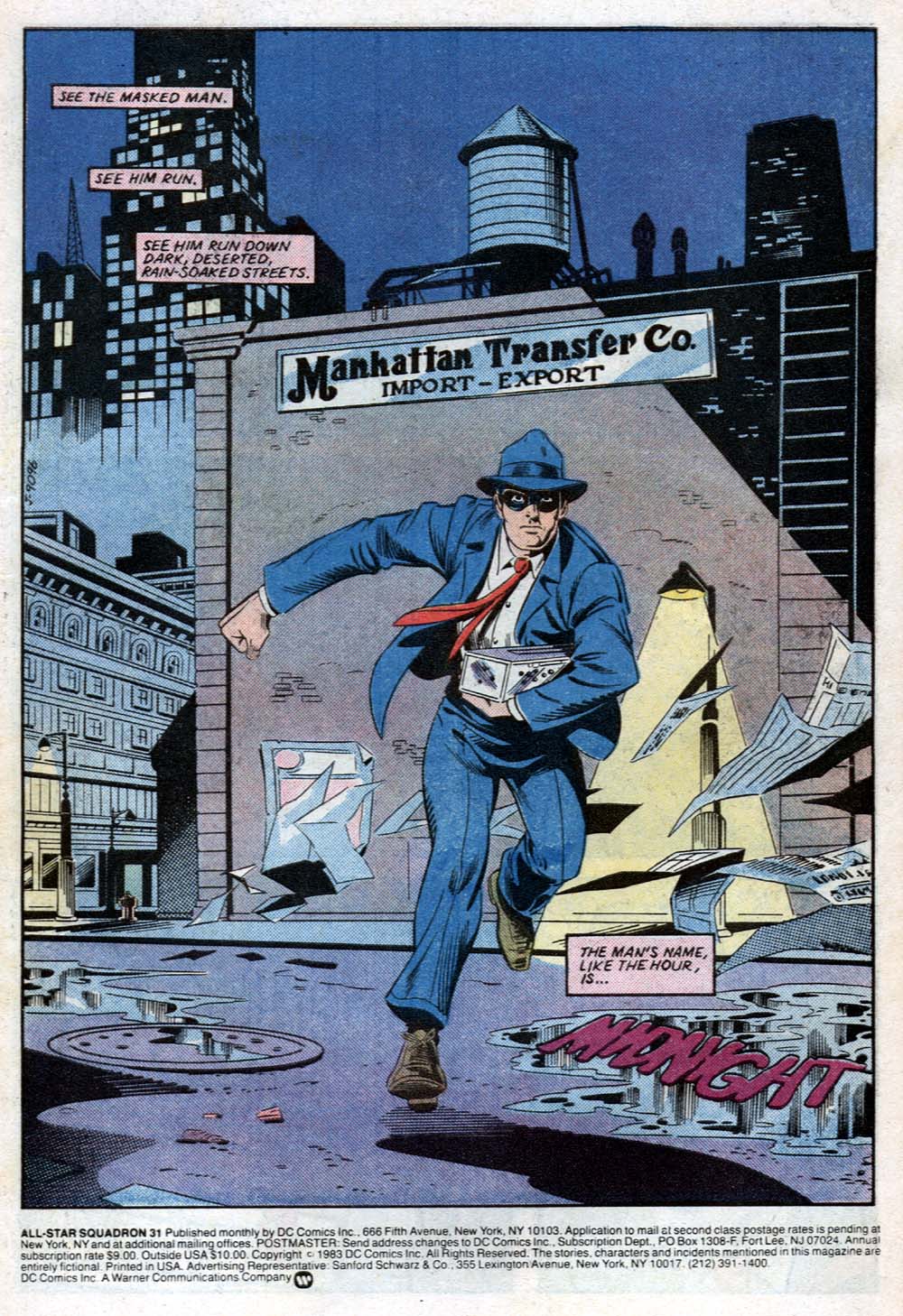 He is carrying a metal box and is being chased by German agents (in uniform, in New York, in 1942. That takes der hoden!) They shoot at him and he decks one (while hiding behind a sign in Hebrew) and he makes it to a subway train. Hawkman and Hawkgirl are flying over New York and she is teasing himn about the JSA not making her a member, but going "Ga-ga over that upstart Amazon in a star-spangled girdle." She is happy to be back with the All-Stars and their Nick & Nora bit is interrupted by a meeting with The Ray and Black Condor, who are headed the same direction, which is Flushing, and the New York World's Fair grounds, where the All-Star Squadron are ehadquartered, in the Trylon and Perisphere. There, they join the very first meeting of the entire roster of active mystery men and women... 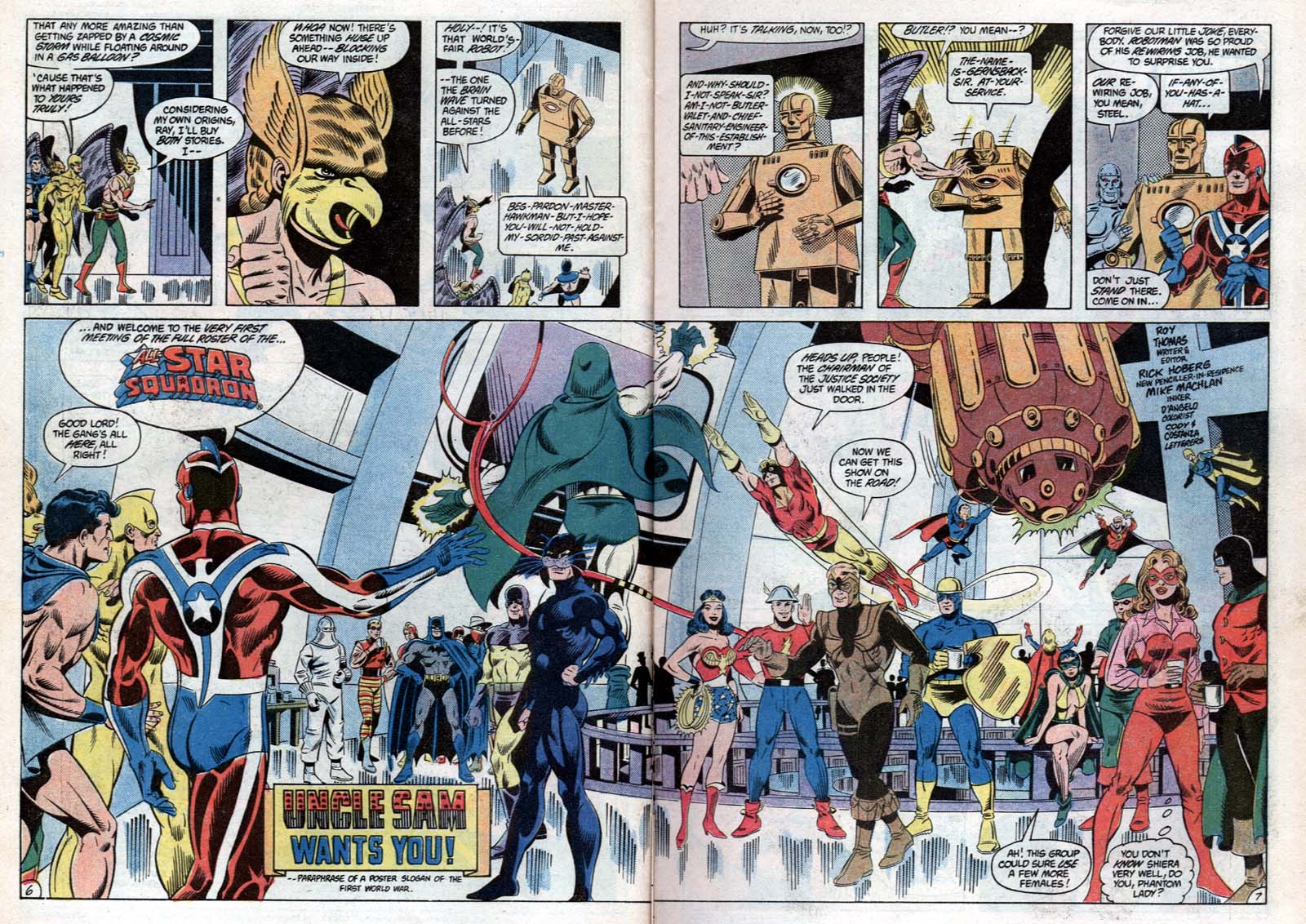 While the adults talk among themselves, the sidekicks pick fights over whose mentor is better, with Robin and Speedy going at it, while Sandy looks on. Somehow, Stripesy avoided a seat at the kids' table and is with the adults, as is Star-Spangled Kid, despite the name. The two Manhunter's meet up and it doesn't go smoothly. Starman Ted Knight is reuinited with his cousin, Sandra, aka Phantom Lady, recognizing her under the goggles. She recognizes him because he doesn't wear a mask, but no one else seems to. Strange world, the 1940s. Liberty Belle displays new duds, trading jodhpurs for tight pants, buccaneer boots and a spiffy red cape (though, since she doesn't fly, is likely to be a hazard). Hawkgirl approves, as do the men when they see how it hugs her body more than the old one. Johnny Quick shows up and Belle is a bit chilly to him, and after some small talk, she calls the roll... 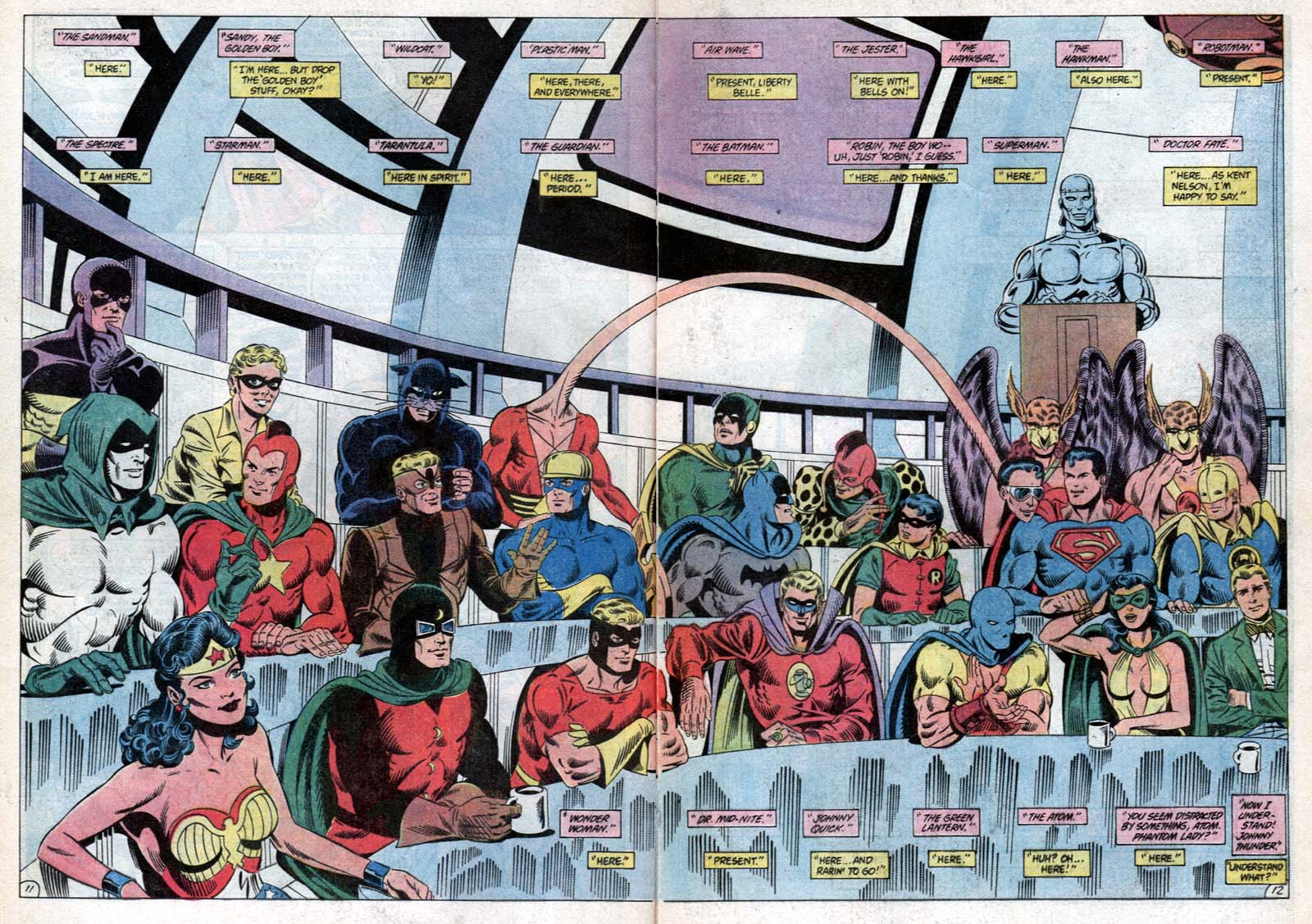 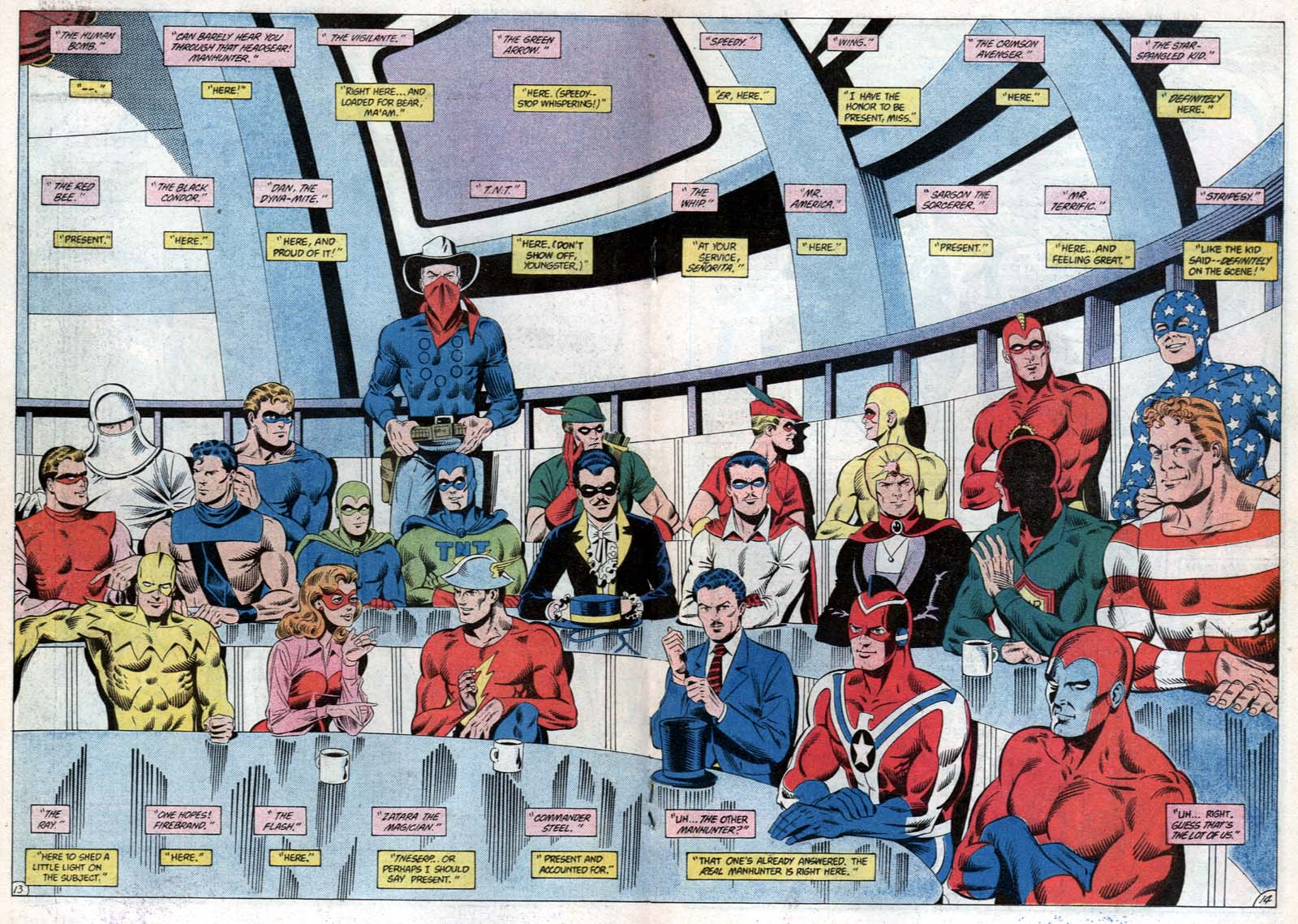 Having no old business, they get down to new business. Shining Knight is protecting England, while Amazing Man is on R&R, in Detroit. The Blackhawks, who aren't mystery men, Roy, are off killing Krauts and singing about it. "over land, over sea, we fight for do-re-mi, for we're Black and Blue Hawks!" Wait, that was Mad's Black and Blue Hawks! CDR Steel and Robotman hand out communication devices and President Roosevelt makes a speech, via television. The proceedings are then interrupted by someone who outranks FDR.......Uncle Sam! 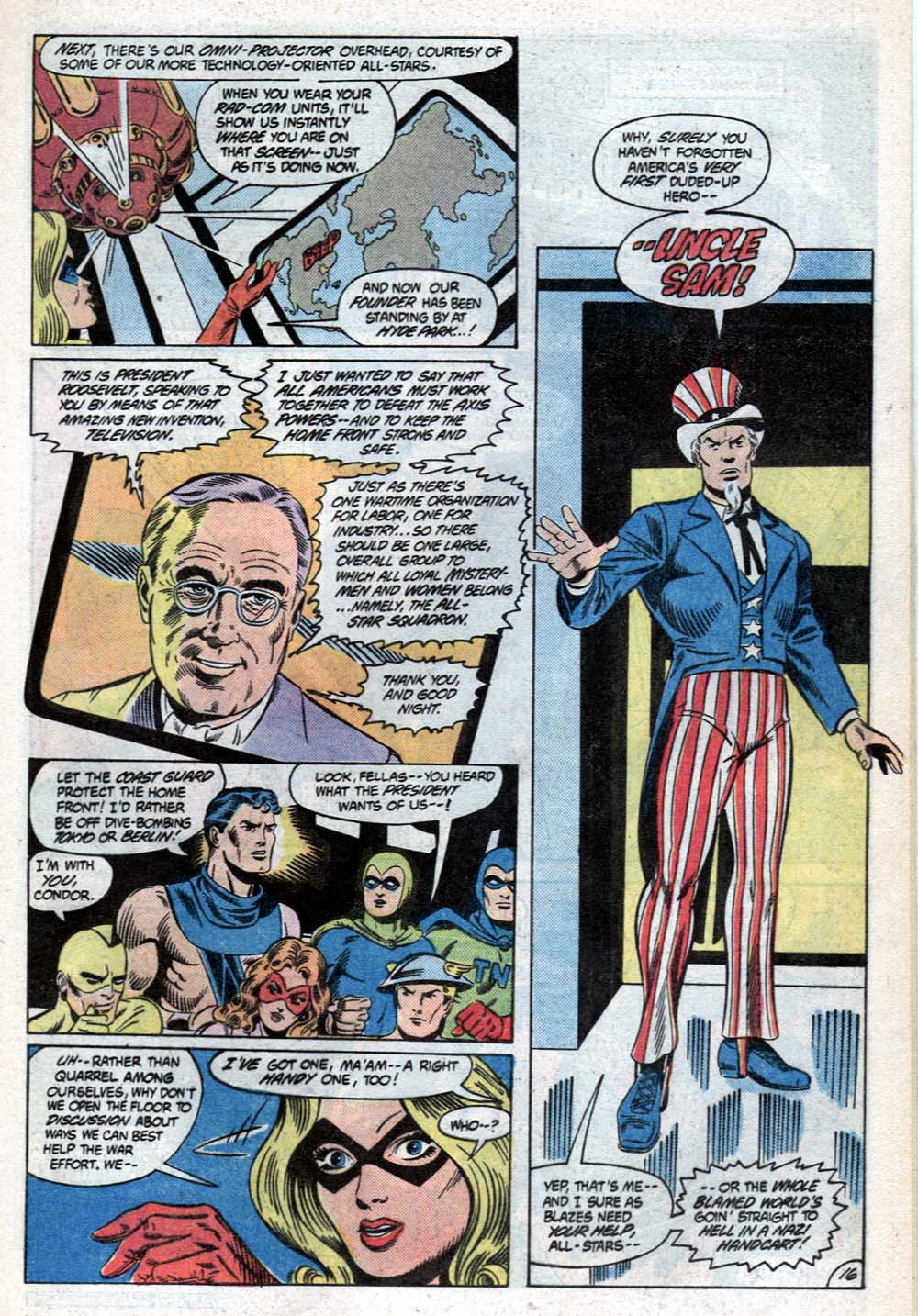 Meanwhile, Midnight has been cornered on a train and fights his way through, catching a bullet in the shoulder, but using a stolen Luger to do the same to a Ratzi, who drops a potato masher and blows up the train (well, it crashes). It's a hand grenade, not a satchel charge, Roy! Uncle Sam continues, relating how he has been there through all of America's wars, then, as he was whoopin' some Nazi hide, he got as headache and opened a portal between worlds, which brought him to Earth-X, a world without superheroes but plenty of Nazis. In fact, they were doing far better than the Earth-1, 2 and Prime Nazis. US recruited a bunch of mystery men to join him, including Magno, Red Torpedo, Miss America, Neon the Unknown and the Invisible Hood (Stormy Foster must have been occupied). They were joined by Hourman, of the JSA. They crossed over to fight the Ratzis; but, they were killed and US needs more powerful heroes. Spectre claims he has seen no other Earths and Sargon claims he would sense another world. Liberty Belle says they are needed on this world; but, some heroes disagree and join Uncle Sam, including The Human Bomb, The Ray, Black Condor, The Red Bee, and Phantom Lady. Everybody else chickens out and stays on Earth-2. The debate is interrupted by the arrival of Midnight, who collapses and the metal box opens, revealing a possibly dying Doll Man. Thoughts: Whoooooeeeeeeeee! Now there's a set-up. First, Roy gives us a gathering of all of the DC and most of the Quality heroes who existed in 1942, though he missed a few, including the Quality Comics characters Hercules and Stormy Foster, as well as Quicksilver, who would later be known as Max Mercury, the infamous Madame Fatal (a cross-dressing actor who fights crime disguised as an old lady), The Clock, and Alias the Spider. Also missing are Little Boy Blue and the Blueboys, Red Tornado (Ma Hunkel), and Mr America. Aquaman is name dropped and shown with yellow gloves, to signify the GA Aquaman. For the un-initiated, Quality Comics began in 1937, founded by Everett "Busy" Arnold, who hooked up with three comic strip syndicates to reproduce material in comic books, including Joe Palook and Dixe Duggan. He also bought material from the Harry "A" Chesler shop and quite a bit from the Eisner & Iger shop, including most of the material that would debut the Freedom Fighters chaarcters, drawn by Eisner, Lou Fine and Reed Crandall, among others. Quality had some of the best artists in the business and published some of the most popular comics of the 40s, including Jack Cole's Plastic Man and Blackhawk. They also published Will Eisner's Spirit Sunday suplement, which also featured Lady Luck and Magicman. Arnold loved the Spirit and commissioned his own version of it for his comics, which was Jack Cole's Midnight, featuring a similarly attired masked detective. Quality ceased publishing in 1956 and sold of most of their characters and titles to DC. Len Wein would then take their superheroes and put them together as the Freedom Fighters, the heroes of Earth-X, where the Nazis won WW2 and they continued fighting them. The JLA and JSA meet up with them and help them free the world from Nazi tyranny. Then, a bit later, the Freedom Fighters characters came to Earth-1, hunting the Silver ghost, a supervillain who framed them for a crime, making them fugitives on Earth-1. The storyline was never fully resolved, as the FF comic was cancelled and the resolution was axed when Secret Society of Supervillains, which was supposed to pick up the ending, was cancelled in the DC Implosion. This storyline answers the question of whether there were Earth-2 counterparts to the Freedom Fighters or if they were Earth-X residents. Roy gives us the best of both worlds, as they cross over with Uncle Sam to fight on this new world. The early bunch were lesser characters in the Quality pages, so making them cannon fodder was no big deal. With the second batch, astute readers will have figured out who is going to survive and who isn't. James Robinson would later revisit many of these heroes, both in the pages of The Golden Age (adding Madame Fatal and Captain Triumph, as well as a cameo by Hercules and Stormy Foster) and in the Starman "Times Past" issues, where we see an adventure between Ted and cousin Sandra, and an appearance by the Jester, fighting Bobo Binetti. DC later put out new Freedom Fighter comics, but I had enough toilet paper and never bought them. The World's Fair robot, Elektro, has been renamed Gernsback, in honor of writer/publisher Hug Gernsback, whose name lives on with the Hugo Awards for Science Fiction. The German agents running around the streets of New York, in uniform, with no one questioning it, is a bit too much, for me. This wasn't 1940; it's deep in wartime. Bundists kept their mouths shut and German agaents weren't out to advertise the fact. Still; comics. The irony of Hawkgirl's jab about the Amazon in the star-spangled girdle is that, to Wonder Woman, her "girdle" is gold: her belt. Part of her birth was with the 12 Labors of Hercules, where Hercules had to obtain the Girdle of Hippolyta, and wasn't exactly diplomatic in how he did it. Her belt, or girdle, helps symbolize the history of the Amazons, as do her bracelets, which signify their subjugation by Hercules, until the Amazons regained their freedom. In the tv series, they made the girdle the source of WW's Amazonian abilities, in "Fausta, The Nazi Wonder Woman;" but, someone forgot to tell the writer of "The Feminum Mystique," who made the bracelets the source of their power. Meanwhile, Shierra shouldn't be throwing shade WW's way, while parading around in a red bikini top and red and green briefs and tights. There were cabaret dancers who were more demurely attired. Roy and Rick throw in a few jokes with the roll call, including Atom being distracted by Phantom Lady's cleavage. The Manhunter bit would be handled by Roy, during the Millennium event. Dan Richards was retconned as a Manhunter agent, via the Cult of the Manhunters, as was Paul Kirk. The pair meet up and share an adventure in Young All-Stars, while their pasts were detailed in Secret Origins (along with Kirk's post-war history and the android Manhunters and Mark Shaw). The elder Richards was also used in Infinity, Inc. Most of these characters will not be seen again, as Roy stuck with his favorites. Too bad, as there were some good characters that could have used tome attention. Dan the Dyna-Mite would end up in Young All-Stars, but Paul Kirk was left alone and I don't recall that he used Captain triumph or Kid Eternity, later, though they appeared later in time (Kid Eternity at the end of 1942 and Captain Triumph in 1943). Historical Notes: Roy name drops the Port Darwin attack and the order for MacArthur to withdraw from the Pilippines, which we have already discussed. So, on to March 1942. Yugoslavian Partisans, in Serbia, assassinated Dorde Kosmajac, in Belgrade. Yugoslavia was invaded by Germany and its allies in 1941 and the country was partitioned, with Germany placing Serbia under direct military control, with a puppet civilian administration. German command was mixed with Bulgarian troops. This map shows the areas of occupation... 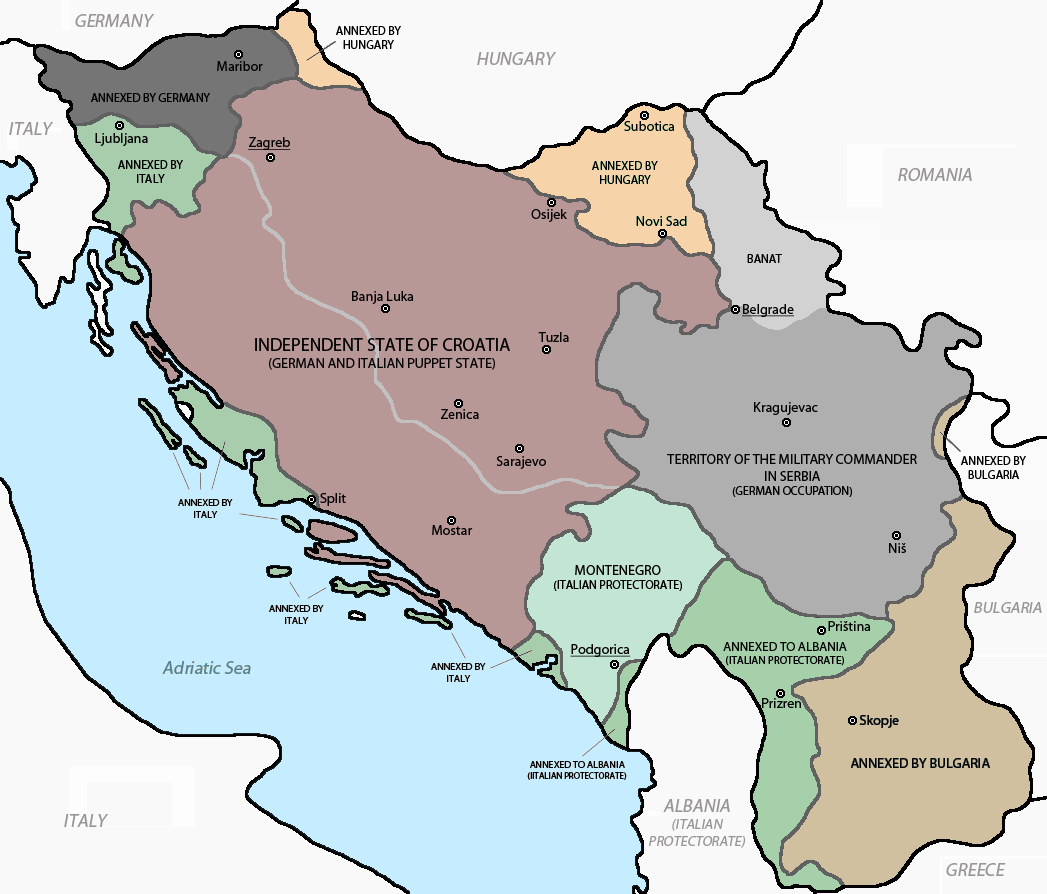 Resistance within the Serbian zone was fractured between the Communist partisans, under Tito, and the monarchists Chethinks, under Draza Mihailovic. Both sides fought amongst each other as much as with the Germans (not too dissimilar to the French Maquis and the Communist resistance). After some success in early stages of the invasion, the Chetniks scaled back operations, in the face of German reprisals on civilians and some Chetnik units actively collaborated with the Germans, especially against ethnic targets (such as Croats and muslims, as well as Communists). The Chetniks dated back to 1918, in guerrilla fights against the Ottoman rulers. During the interwar period, with the founding of a new state, the Chetniks were a leading patriotic organization, within a state that was troubled by divisions. Macedonia had sympathies with Bulgaria and there were tensions between the Serbs and the Bulgarians, especially with the government in Belgrade favoring the Serbs. In the face of a new war, the Yugoslavian Army recognized that it couldn't stand and prepared for guerrilla warfare, using past Chetnik models as their template. When war broke out, there was some co-operation between the Chetniks and the Partisans, who were also heavily Serbian, early in the war; but, it didn't last. The Chetniks pulled back and bided their time for the Allies to come to their aid. The Communists reacted to the invasion of Russia and went on the offensive. Over time, they grew into more of a multi-ethnic force, depending on the region. Chetniks aided the Germans in attacking the Partisans, while the Partisans attacked both the Germans and the Chetniks and Ustashe, the Croatian fascists. The Allies argued over which side to back and the SOE and OSS placed observers with both, with the Chetniks favored early on, before support turned to the Partisans, despite the reservations of siding with the Communists. The Partisans proved an effective fighting force, to where, by 1943, they were inflicting losses on the Axis occupiers that they could not afford. Ultimately, the Partisans were recognized at the Tehran Conference, at the end of 1943, annointing them as the Allied Forces in Yugoslavia. The war in Yugoslavia was as much a civil war as it was against outside invaders, as much effort was spent between the various factions (Chetniks, Partisans, Ustashe, Croatian Home Guard, Serbian Volunteer Corps, Serbian State Guard, and Slovene Home Guard) as against the Axis forces of Germany, Italy, Hungary and Bulgaria. When Italy surrendered tot he Allies, it left 17 divisions in Yugoslavia, some of whome joined the Partisans and all of whom refused to aid the Germans. Some joined partisans, some surrendered to the Germans, some to Croation forces. The Allies, after reports from the field praised Partisan aggression and criticized Chetnik timidity, threw their support to the Partisans. With the Russians on the move, the Germans were thrown back, especially after Bulgaria switched sides, and a coup in Romania put Romanian forces under the Red Army. In the fall of 1944, the Soviet forces entered Yugoslavia. The US Army Air Force provided bomber support for offensive operations, combining th Red Army, its allies and the Partisans, in central Serbia, leading to the liberation of Belgrade, on Oct 20, 1944. By end, the Allies held eastern Yugoslavia, including Serbia, Montenegro, Macedonia and the Dalmation coast, though the Germans held The Independent State of Croatia. They held into 1945, but began a slow withdrawl and Sarajevo eventually fell. Because of Allied support and after offering amnesty to collaborators, Tito and the Partisans were in a position to rule post-war Yugoslavia, which held through Tito's lifetime, but which began unraveling later, before completely breaking down into civil war and ethnic-motivated violence, seen in the 90s. World War 2 in Yugoslavia is less cut and dried, compared to most of the invaded territories, as much of it was an internal struggle as it was an external. History books tend to gloss over the complexities of the war, focusing on bigger picture battles, which ignores similar aspects in France (communists and other groups), the Netherlands (the Dutch fascist party and collaboration with the Germans and Dutch SS troops on the Eastern Front), unrest in Palestine and India, and other complexities that don't quite fit into the Good Guys vs the Bad Guys. March also saw major events in the Holocaust, as Auschwitz goes operational and begins taking in prisoners, while Belzec is opened in the Lubin district of Occupied Poland. It was also an extermination camp. At Riga, nearly 4,000 Jews, who were deported to Latvia, were massacred on the 15th and 26th. The Germans burned the Ukranian village of Yelino, killing nearly 300 civilians. At the end of March, the Japanese occupied the Christmas Islands, after a mutiny by Indian troops, under British command. On the upside for the Allies, the British Navy fought off a superior Italian force near Malta, during the Second Battle of Sirte and carried out the St Nazaire Raid. Combined Operations sent in a joint Royan Navy and Commando force to destroy the drydock at St Nazaire, in occupied France, which was used to refit German naval vessels, including the Bismark, after the Battle of Denmark Strait. The British sought to deprive the Germans of its use and devised a plan to destroy the drydock, the gates that controlled water pumping and any u-boat operations possible. A former US destroyer (rechristened HMS Cambeltown) was packed with explosives and sailed to the harbor and deliberately rammed the gates of the drydock. meanwhile, the commando force was offloaded to deploy demoltion charges and destroy as much equipment as possible. The force succeeded in ramming the gates and wedging the ship into it; but, it failed to detonate on time. Commandos deployed and there was some success in destroying pumping areas and other targets, but with heavy casualties and some of the commandos were cut off from withdraul and had to fight it out until their ammunition was exhausted. The Cambeltown was supposed to detonate at 0430 Hours, but did not go off, possibly due to acid-based detonators failing. However, while captured prisoners were being interrogated by the Germans, the detonators went off and the ship exploded. The damage put the drydock out of commission for the remainder of the war, denying its vital use to the Germans. Hitler was incensed that the british were able to sail a flotilla up the Loire, unhindered and refocused attention on the Atlantic Wall, building fortifications at ports to prevent such operations. The raid inspired the movie, Attack on the Iron Coast, with Lloyd Bridges (one of several wartime action films from Oakmont Productions, a British company that used American leads, to give the films bigger appeal in the US).
|
|
|
|
Post by mikelmidnight on Jul 31, 2020 12:49:14 GMT -5
Whoooooeeeeeeeee! Now there's a set-up. First, Roy gives us a gathering of all of the DC and most of the Quality heroes who existed in 1942, though he missed a few, including the Quality Comics characters Hercules and Stormy Foster, as well as Quicksilver, who would later be known as Max Mercury, the infamous Madame Fatal (a cross-dressing actor who fights crime disguised as an old lady), The Clock, and Alias the Spider. Also missing are Little Boy Blue and the Blueboys, Red Tornado (Ma Hunkel), and Mr America. Aquaman is name dropped and shown with yellow gloves, to signify the GA Aquaman.
Also missing: Guardian Angel (Hop Harrigan), Genius Jones (granted, he was more a humor character), Lando the Magician, Flying Fox (Rex Darrell), Gay/Grim Ghost, Minuteman (Hourman's sidekick), Captain X (granted he was in Europe), the King, the Witch, and I always thought they should have tried to nab Jim Anthony.
In regards to Quality Comics, they had a couple dozen other characters too obscure to rate here, in addition to the ones you mention. I was NOT happy with their inclusion: I thought it undermined the original Earth-X story, plus Roy already had more characters in play than he could effectively write.
(Plastic Man and Blackhawk being the exceptions, as DC had already been publishing them for decades)
|
|
|
|
Post by masterofquackfu on Aug 3, 2020 10:24:44 GMT -5
I used to love the All-Star Squadron in the 80's. However, after visiting it again a few years ago, ugh...it just wasn't very good. Staid writing and very, ahem..DC. So ended up selling all of the old issues. The book had its day, but that day is done and gone.
|
|
|
|
Post by dbutler69 on Aug 3, 2020 13:32:56 GMT -5
All-Star Squadron #31The irony of Hawkgirl's jab about the Amazon in the star-spangled girdle is that, to Wonder Woman, her "girdle" is gold: her belt. Part of her birth was with the 12 Labors of Hercules, where Hercules had to obtain the Girdle of Hippolyta, and wasn't exactly diplomatic in how he did it. Her belt, or girdle, helps symbolize the history of the Amazons, as do her bracelets, which signify their subjugation by Hercules, until the Amazons regained their freedom. In the tv series, they made the girdle the source of WW's Amazonian abilities, in "Fausta, The Nazi Wonder Woman;" but, someone forgot to tell the writer of "The Feminum Mystique," who made the bracelets the source of their power. Meanwhile, Shierra shouldn't be throwing shade WW's way, while parading around in a red bikini top and red and green briefs and tights. There were cabaret dancers who were more demurely attired. I hated that they made Wonder Woman's girdle (well, I think they called it a belt on the TV show) the source of her powers on the TV show! Terrible choice! However, was that stated to be the case in season 1 (which took place during WWII) or did they come up with that for season 2 (which took place in the 70's)? I remember it coming up in season 2, but I don't remember it in season 1, but then again, my memory sucks. By the way, I loved this particular issue. I loved seeing so many superheroes gather together and thought Roy Thomas handled it well, even throwing in some characterization. I also loved the drama with Midnight (whom I'd never heard of before) avoiding Nazis to deliver this mysterious package, and I liked how Roy sort of poked fun at Black Condor's origin (the only reason you can't fly is because you don't want to badly enough). I read that Manhunter Millennium thing not too long ago and thought it was pretty good, also. By the way, Doll Man was apparently the third most popular Quality feature after Plastic Man and Blackhawk. I may have read that in a Roy Thomas comment in a letters page somewhere. |
|
|
|
Post by dbutler69 on Aug 3, 2020 13:39:24 GMT -5
All-Star Squadron #31For the un-initiated, Quality Comics began in 1937, founded by Everett "Busy" Arnold, who hooked up with three comic strip syndicates to reproduce material in comic books, including Joe Palook and Dixe Duggan. He also bought material from the Harry "A" Chesler shop and quite a bit from the Eisner & Iger shop, including most of the material that would debut the Freedom Fighters chaarcters, drawn by Eisner, Lou Fine and Reed Crandall, among others. Quality had some of the best artists in the business and published some of the most popular comics of the 40s, including Jack Cole's Plastic Man and Blackhawk. They also published Will Eisner's Spirit Sunday suplement, which also featured Lady Luck and Magicman. Arnold loved the Spirit and commissioned his own version of it for his comics, which was Jack Cole's Midnight, featuring a similarly attired masked detective. Quality ceased publishing in 1956 and sold of most of their characters and titles to DC. Len Wein would then take their superheroes and put them together as the Freedom Fighters, the heroes of Earth-X, where the Nazis won WW2 and they continued fighting them. The JLA and JSA meet up with them and help them free the world from Nazi tyranny. Then, a bit later, the Freedom Fighters characters came to Earth-1, hunting the Silver ghost, a supervillain who framed them for a crime, making them fugitives on Earth-1. The storyline was never fully resolved, as the FF comic was cancelled and the resolution was axed when Secret Society of Supervillains, which was supposed to pick up the ending, was cancelled in the DC Implosion. Oh, by the way, Bob Rozakis had another issue plotted beyond what was pencilled and made it into Cancelled Comics Cavalcade and the SSOSV collected edition, in which the original Firebrand joins the team, and he and the Silver Ghost are killed in the final battle (Ray dies somewhere along the way, too), and the FF decide to return to earth-X. |
|
|
|
Post by codystarbuck on Aug 3, 2020 21:28:16 GMT -5
Well Firebrand, was already in the book, in the last few issues, after he revealed himself. If memory serves, he hid out on Earth-1, when things got bad. I originally had the last two issues of the series, bought on the newsstand, and he was a part of the team. I later bought the whole series, and I think he turned up one or two issues before that (which would be #12 or 13). At the end of issue 15, they are looking to clear their name and hunt down the Silver Ghost. That was supposed to appear in the next issue of SSOSV. That issue was axed in the Implosion and is in Cancelled Comic Cavalcade (I have scans).
Doll Man was drawn by Crandall for a lot of his run, with Lou Fine in there early; that would make any book popular. Blackhawk was always big but really got big with Crandall. Fine did amazing work on Black Condor, which still has the best flying scenes in comics. None of this ballistic flight across the page, in profile; he swooped and dove and soared, like a bird. Fine just went to town with the body language like no other. Fine also handled the Ray, early on, which was fantastic. I believe Crandall also handled Firebrand, for a bit.
Fine also handled Quality's Hercules and Stormy Foster strips.
|
|
|
|
Post by codystarbuck on Aug 5, 2020 17:27:27 GMT -5
All-Star Squadron #32 Creative Team: Creative Team: Roy Thomas-writer/editor, Rick Hoberg-pencils, Bill Collins-inks, Albert de Guzman & Cody Weiss-letters, Gene D'Angelo-colors. Bill Collins had been an art assistant to Dick Giordano and will be inking the book for a bit. Synopsis: We pick up where we left off, as Doll Man proves to be alive and Midnight has recovered and is being patched up, fittingly, by Dr Mid-Nite... 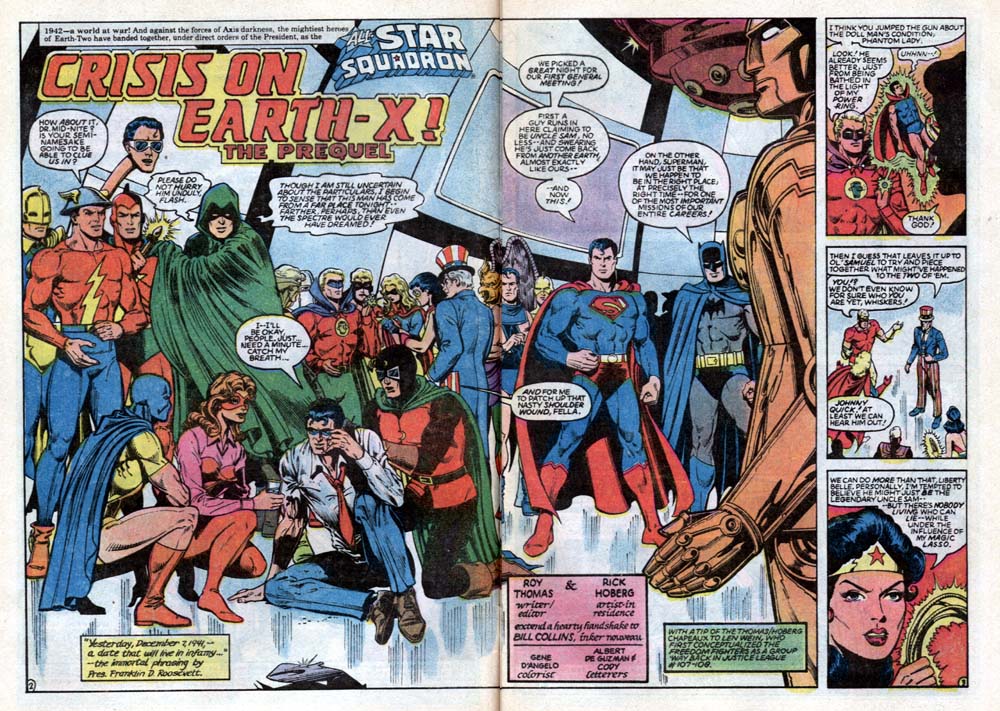 Uncle Sam explains what happened. He travelled through a dimensional portal and found the Nazis raging across Europe, unmolested. he fought some brownshirt types (the Steel Helmets) in the US, then got visions of a future attack on Pearl harbor. he went back to Earth-2 to recruit some heroes, and found Red Torpedo, Magno, Neon the Unknown, Miss America and the Invisible Hood, but needed someone with some experience and tried to recruit Hourman. Rex Tyler thought he was a loon and told him to hit the bricks. Sam gets ornery and grabs Tyler, tearing his lab coat and revealing his costume below. he's been trying to perfect a miraclo ray, lo lessen the dependence on the pills; but, pops one anyway to fight US. Sam is pretty spry for his age and can tussle with the best of them and Hourman is shocked. he lets up and Sammy introduces him to the B-team. Rex says he will jopin Sam's band of Freedom Fighters and Len Wein loses credit for naming the bunch (though it didn't includes these guys). They pop off to Earth-X and arrive in Hawaii, in mid-December and stop a Japanese air attack. 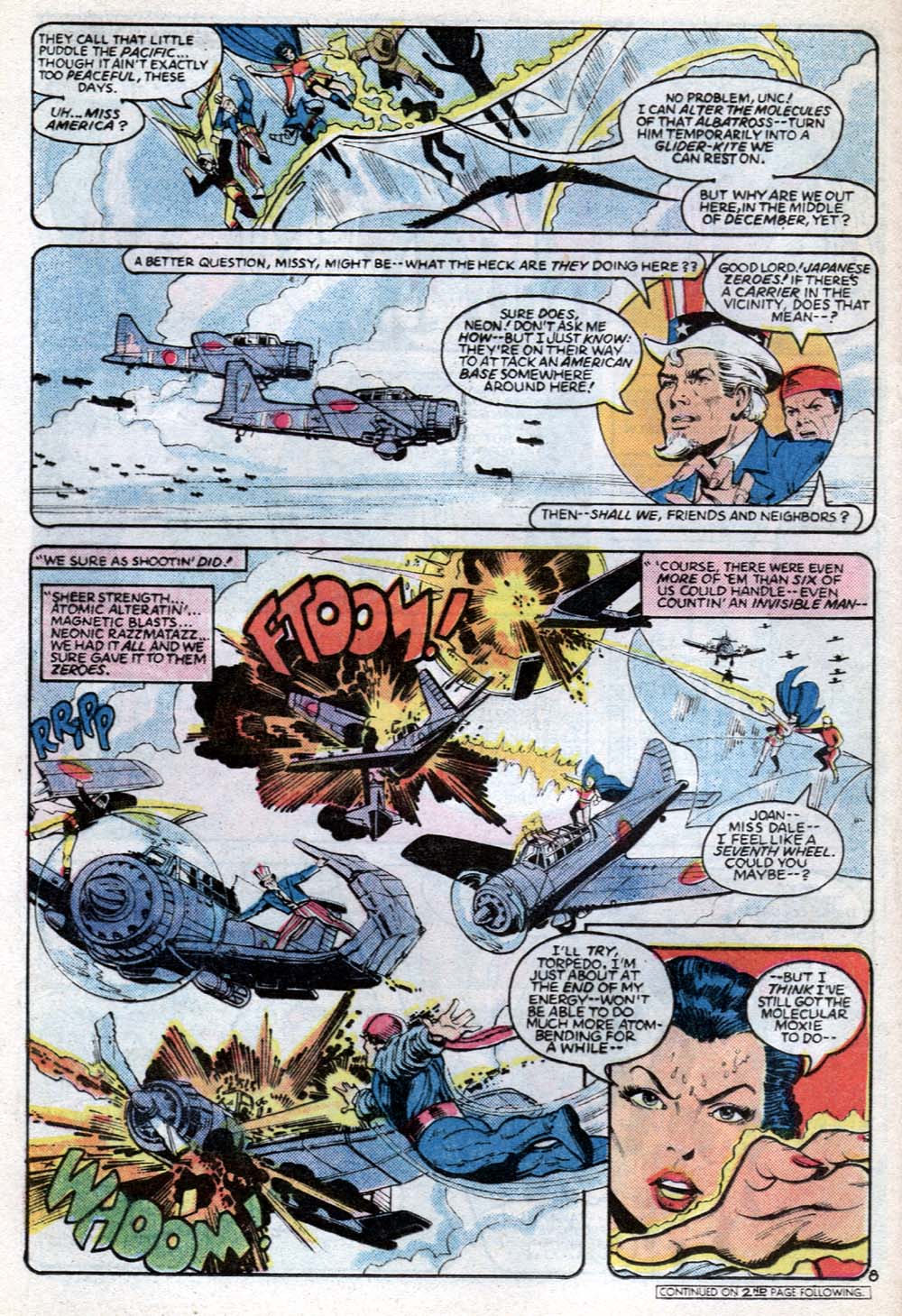 Admiral Nagumo gives orders to fight to the last man to destroy the Freedom Fighters. They are enjoying their victory, standing on the deck of Red Torpedo's little sub, when a Zero pilot goes on a kamikaze dive and slams into it, leaving only Sam alive. 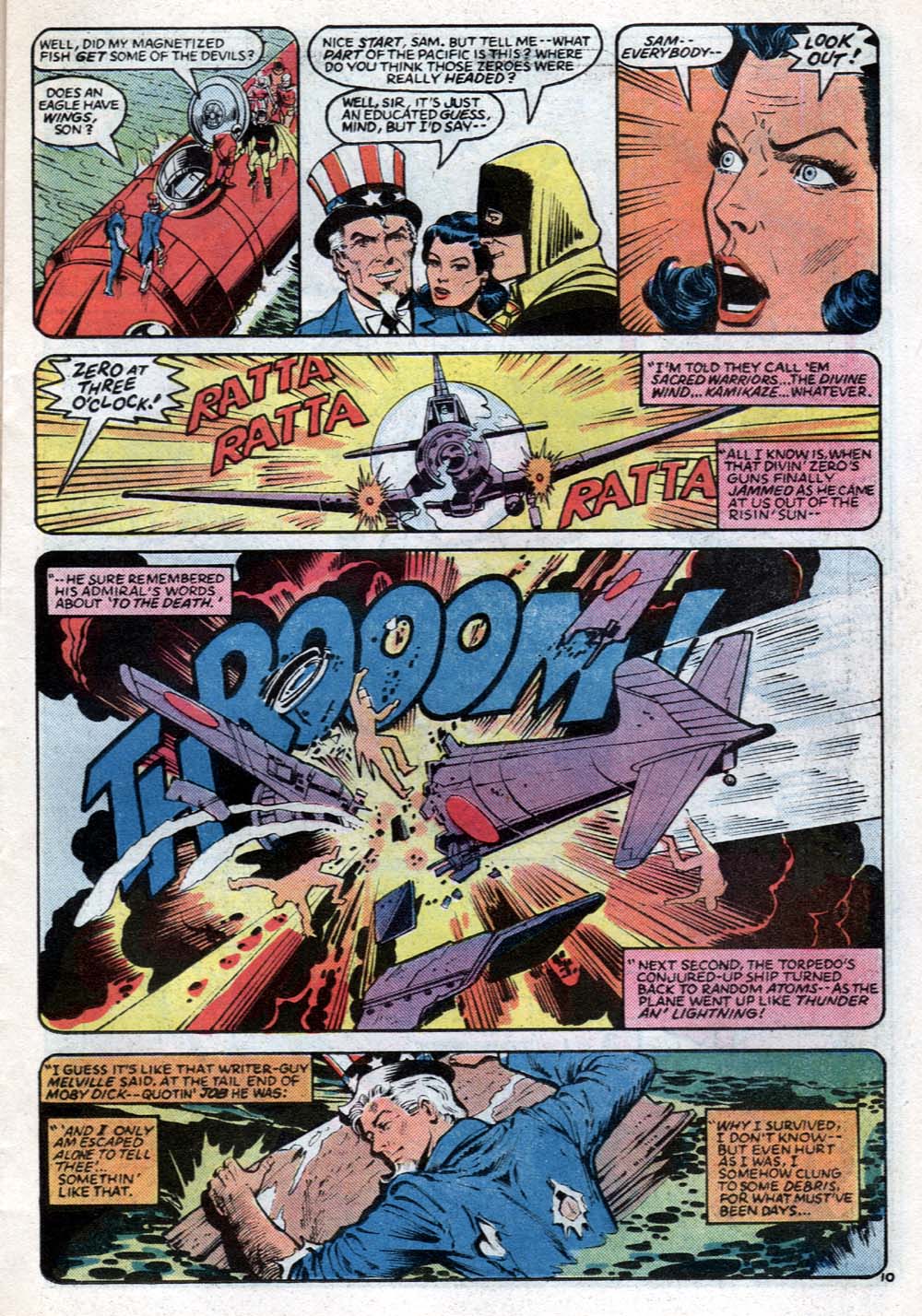 Sam floated to shore and was picked up by soldiers, who thought he was nuts. He was dumped in a padded cell, and spent several weeks there, seeing the changes in history in the papers. America remained neutral, while the Japanese made attacks on Singapore, Hong Kong, Thailand, and are threatening the Russians, to the East. However, the Japanese were massing their fleet for a sneak attack on the US West Coast. Sam came back for more help. Midnight corroborates things, after asking to be wrapped in WW's lasso (kinky!). He and Doll Man heard about Uncle Sam and tracked him to the chemical factory, but arrive in time to find the rest transiting the portal. they follow; but, end up in occupied Paris. They halt an execution of a pair of resistance fighters and end up working with the Maquis. They hear a radio transmission to the Germans about the planned Japanese attack and then spot Baron Blitzkrieg as the recipient. He spots Doll man fighting a rat and smashes through the window. 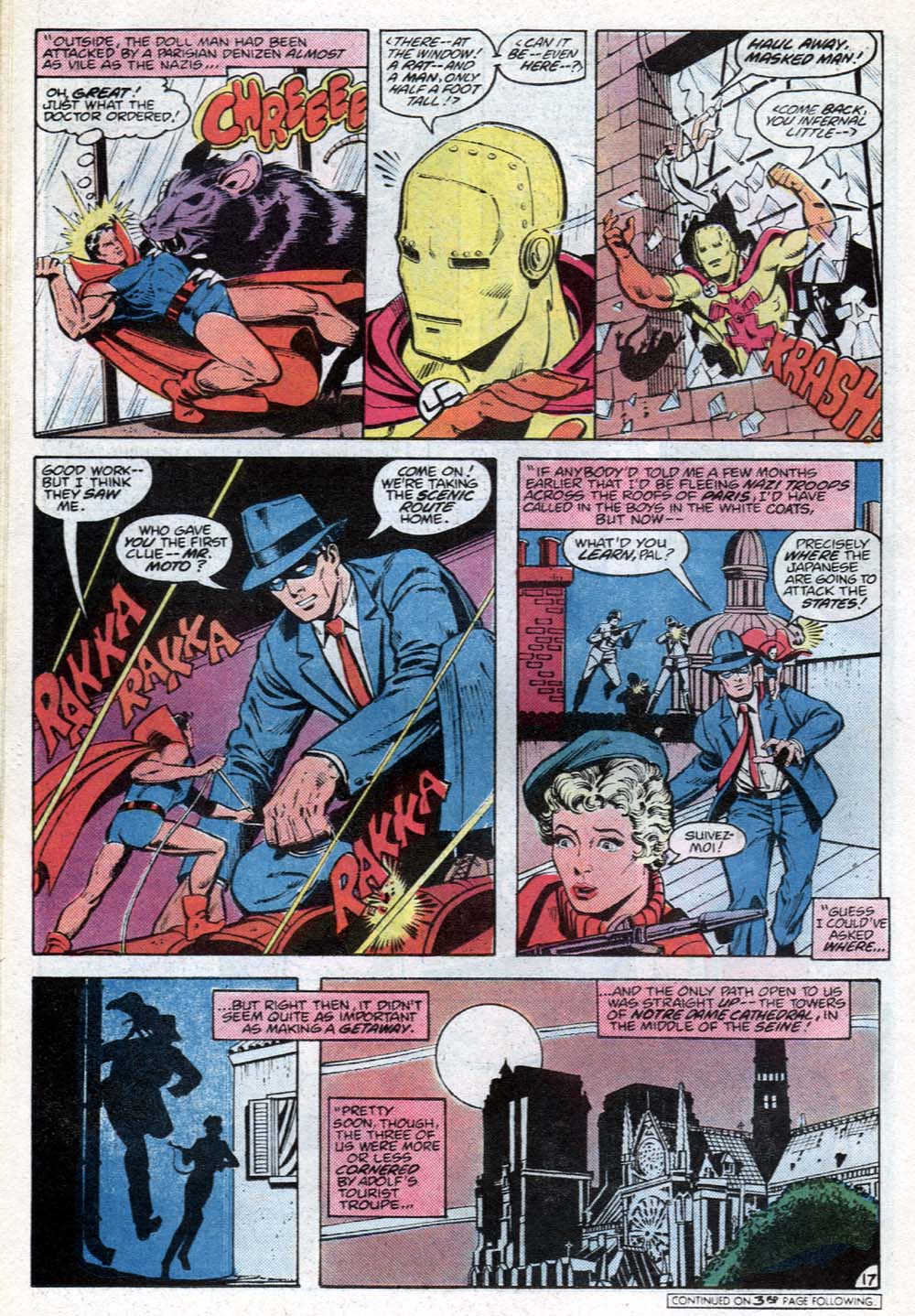 DM, Midnight and Mam'selle Not-Marie take off across the roof. The end up cornered in Notre Dame. Not-Marie is shot dead and BB hits DM with his Nazi vision, knocking him for 6 and Midnight spots the patriotic dimensional gate and jumps through, followed by a bunch of sausage-eaters and we are back where we started. Liberty Belle authorizes a task force to go with Uncle Sam. Meanwhile, radio reports of a Coast Guard cutter missing on the West Coast have them wondering if there is a conenction between the two worlds that might affect their own history. The rest of the Squadron heads off to California to check things out, while Uncle Sam leads the new Freedom Fighters to Earth-X. Spectre provides transport, but is blocked by his boss from accompanying them. They arrive to face the attack on Santa Barbara.... 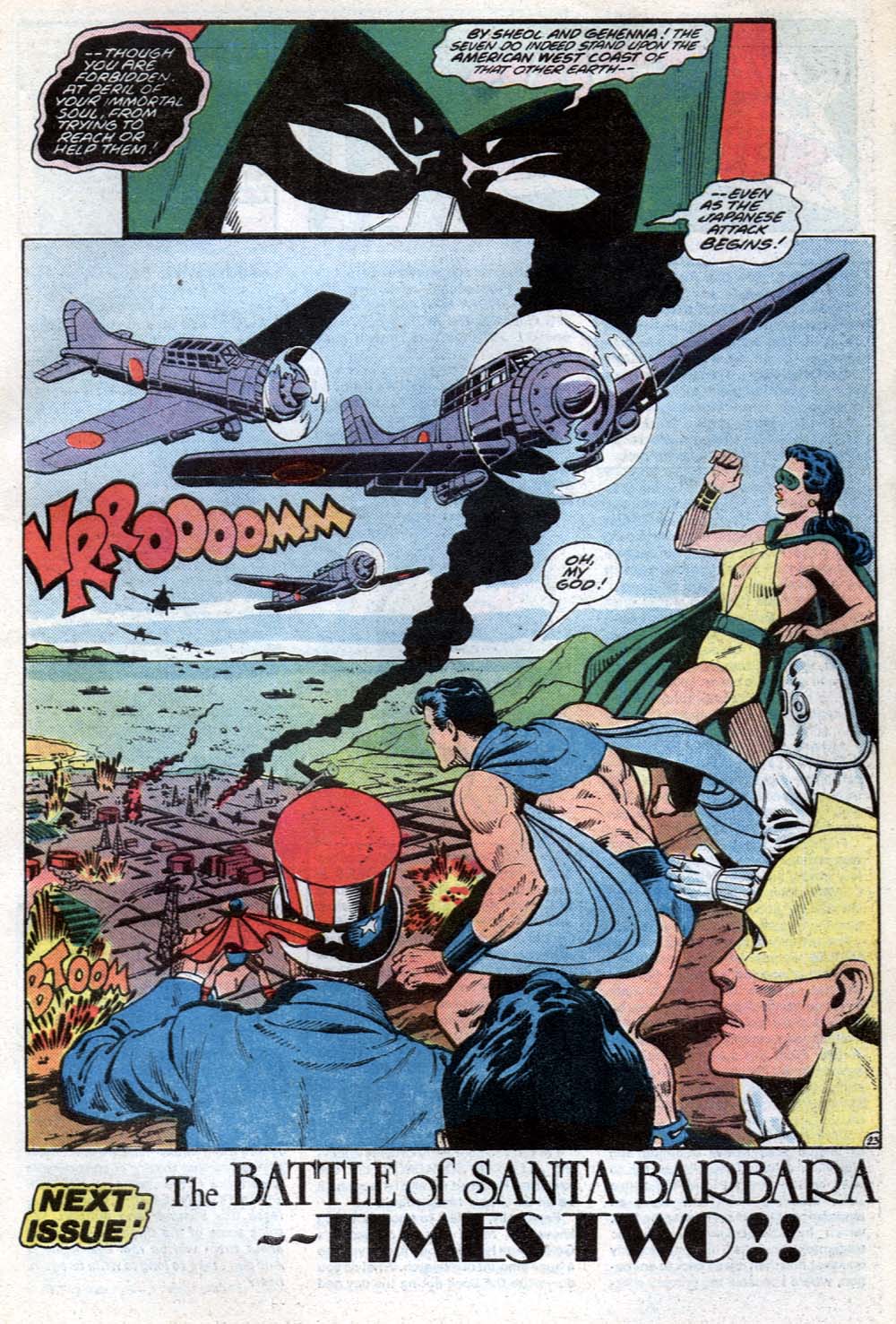 Thoughts: Thoughts: So, Roy continues dabbling in alternate history; but, he also demonstrates the problems of such exercises. History is a complex thing and no single event leads to a specific conclusion. According to the newspapers, Sam reads, the Japanese are defeated before they reach Pearl Harbor, but the US is oblivious to that and doesn't declare war. The Japanese carry out their attacks on British Malaya, Hong Kong and Thailand, but not US possessions in the Phillipines and the Marshall Islands. The whole point of the attack was to disable the Pacific Fleet, to prevent them from attacking the Japanese as they executed their war plans to gain Malaya and the Dutch East Indies, to obtain mineral resources and food supplies. The attacks on the Philippines and Wake Island were to extend their security zone around these areas, so they could have a system of air bases and naval facilities to allow them to maintain control over those conquered possessions, extending that security zone away from the Japanese Home Islands. The Japanese ambassador delivered Japan's declaration of war, but the War Department had already intercepted signals that the Japanese had been preparing a strike on US possessions, though there was some doubt as to whether it was an exercise of a real intent. The US had already embargoed steel exports of fuel to Japan, because of its aggression in Manchuria. So, it is unlikely that intercepting the Japanese would have prevented Hawaii from knowing about it. Roy has Nagumo breaking radio silence, which would have been picked up in Oahu. In real history, radar detected the first attack wave when it was 136 nm off Oahu, but a presumption by the officer in charge led to no warning being given. The Japanese also launched mini-submarines, at least one of which was spotted around 01:00 local time and the destroyer USS Ward was alerted and it dropped depth charges. It is unlikely the presence of the Japanese, including wreckage, would have gone undetected. Meanwhile, Japan wouldn't have proceeded with the other attacks, since it needed to secure bases, which was the reason for the attack on the Philippines. Japanese war plans focused intently on combined operations, which means ever part of the strategy was built around multiple components. Take one out of the equation and the other plans have to be drastically altered. More than likely, a failure of the attack on Pearl Harbor would have meant changes in the other Japanese battle plans. So, the idea that things would have progressed in the South Pacific, as they had, doesn't hold up, nor that the US wouldn't have detected evidence of the aborted attack and declared war. The US had already been moving towards a war footing, before the attack, with polls being conducted about support for a war against Japan. American neutrality was mostly directed towards the war in Europe, due to US experiences in WWI; Japan was seen as threatening American interests in the Pacific, which was a different ballgame. Rick Hoberg does a decent job with the art, and tries for some of the more dramatic touches we got fro Adrian Gonzales and Jerry Ordway. Bill Collins inks work well enough and we still have a similar feel to what came before, artistically, on the book, though maybe without the same pizzazz. The story moves along and the European stuff is a bit more interesting, to my tastes, with Baron Blitzkrieg popping up. Now how did he get on a parallel world? Is it a parallel Baron? If so, why would such a figure exist, without American mystery men to prompt his creation? We will have to wait for answers. Roy continues to create a sort of prequel (and names it as such, in this issues title) to Len Wein's JLA story, which introduced the Freedom Fighters. Perosnally, I kind of preferred the idea that they and the rest of the Quality characters were home-grown. Same with the Marvel Family and other Fawcett heroes on Earth-S. Roy wants to play with all of his favorites and bends continuity to fit his needs and had enough carte blanche with DC editorial to do it. Historical Notes: Doll Man name drops Philo Vance and Ish Kabibble. Philo Vance was a detective, appearing in a dozen crime novels by SS Van Dine (Willard Huntington Wright), published in the 1920s and 30s. The Van Dine pen name was also the name of the narrator, who acted as Philo's Watson. The series was very popular and spawned a radio and movie series, with the latter starring William Powell, in the early entries. This fact was brought up in the trailer for The Thin Man, where Powell appears as both Vance and Nick Charles, in a split screen, telling Philo about the plot of his new film. Ish Kabibble (Merwyn Bogue) was a comedian, singer and coronet player, appearing with Kay Keyser and his band, noted for his comedic songs. the name came from mock Yiddish, from one of Bogue's songs, with the lyric isch ga-bibble, which was supposed to mean "I should worry?". There is no such Yiddish expression. The closest to it is "nisht gefidit," which means "it doesn't matter to me." His name would appear here, on this board, as the screen name for our greatly missed Ish, who hasn't been here for a few years. April, 1942. The death camp at Sobibor, begins operations, in Poland. Over 160, 000 people would be killed there. On October 14, 1943, the prisoners, including Russian soldiers, staged a revolt, assassinating SS guards and escaping to freedom. The plan called for the guards to be killed, then assembling all 600+ inmates and walking to freedom, but, the alarm was sounded when only 12 of the officers had been killed. Some 300 prisoners managed to escape and 58 survived the war. The German shut down Sobibor after the escape, though it had been nearing its end already, which prompted the revolt, as a similar decision to shut down Belzec had led to the complete extermination of the inmates. The Belzec inmates had secreted messages in clothing, which were discovered and the Sobibor prisoners formed a committee to plan an escape. A group of Jewsish red Army soldiers were brought in as labor, in the camp and a wary alliance was made, with political officer Alexander Pechersky leading the revolt. Several SS officers were lured to quiet places, under various pretenses and stabbed to death, their weapons taken. Shots rang out and Pechersky yeleld for all to scatter and try to escape and bear witness to the rest of the world about the camp. 300 made it out. Pechersky and a group of soldiers left behind other escapees, saying they were going to look for food, but never returned. they crossed a river and attempted to make contact with partisans. Pechersky felt the odds of survival were greater in separate, smaller groups and was intent on getting back to the Red Army. Estimates are that 158 died attempting to escape, and 107 killed by the Wehrmacht and Opo police, chasing the escapees. The 159 prisoners remaining in the camp were shot and killed by the SS and labor was brought in from Treblinka to raze the camp. Ironically, Treblinka was also be the sight of a prisoner revolt, in August of 1943, when the prisoners used a duplicate key to open an arms storage and steal some 2 dozen weapons and attacked the gates and other areas of the camp. They failed to sever phon lines and most wer slaughtered by machine gunners in the assault and the 200 escapees were located and caught by rapid German response. Some 70 are known to have survived. These actions, the Warsaw Ghetto Uprising, and Jewish partisans in Poland and Russia put lie to claims that the Jews went silently to the gas chambers. Construction on the Treblinka camp was begun in April of 1942. Some 850,000 were murdered there, including 800,000 Jews. Bataan fell to the Japanese and the Death March of American and Filipino prisoners began. The Japanese launched air raids on British-controlled Ceylon, on April 5 and 9th, with the 5th being Easter Sunday. The Japanese used a similar attack strategy as at Pearl harbor, hoping to hit the British Eastern Fleet, and achieved a similar surprise. However, as with Pearl Harbor, the big targets were not there. The Japanese succeeded in sinking the light aircraft carrier Hermes and the light cruisers HMS Cornwall and Devonshire, as well as HMAS Vampire, of the Royal Australian Navy. The Japanese had hoped to disrupt British operations from the Indian Ocean; but, failed to find the main target. This would end up leading to the engagement in the Battle of the Coral Sea, the following month. French general Henri Giraud escaped from Kongistein Fortress, where he had been held prisoner. He would be tapped by the Allies to lead french troops in Africa, after the Operation Torch Landings. At first he refused to cooperate, unless given complete command of the landings. Finally, after much cajoling and outright shaming by Eisenhower, he relented and aided the Allies. he had an uneasy partnership with DeGaulle, which ultimately fell apart. Bambi was released by Walt Disney, on April 12. What better way to escape wartime fears than by seeing a deer's mother shot dead. The Star of David was ordered to be worn in the Netherlands and Belgium, adding them to the occupied nations where Jews were singled out, ultimately leading to removal to the concentration camps. Elements in the Netherlands fought this. On April 18, 16 B-25 Mitchell Bombers were launched from the US base at Shangri-La and attacked the Japanese Home Islands. The base at Shangri-La was better known as the USS Hornet. I discussed the Doolittle Raid earlier. Strategically, it accomplished nothing, as very little damage was sustained to Japan. However, it was a major morale boost, especially given the fall of Bataan. the US had been on the receiving end of attacks and now it was carrying out an attack on the Japanese home, itself, sending a message to the Japanese that they were not out of reach. It led to Japan to reassign aircraft to the home islands for defense and also sowed some doubt into the populace that they had triumphed over the Americans. It would take time before further attacks on the Japanese Home Islands could occur, but it signaled a new stage in America's response to the Japanese. It would also serve to convince the Japanese war cabinet to agree to Admiral Yamamoto's plan to capture Midway Island, a key US base serving both as a mid-point between Hawaii and Australia, but also guarding approaches to Australia. Yamamoto and his staff would plan on a dual attack, with a diversionary attack on the Aleutian Islands and the main attack on Midway. They hoped to draw out the US carriers and deliver them a fatal blow. The US had other plans, but those will wait. The entire island of Malta was awarded the George Cross, for their bravery in holding out against German and Italian attacks. Princess Elizabeth registered for war service. In 1939, it had been advised that Princesses Elizabeth and Margaret be relocated to Canada, but Queen Elizabeth refused, stating "The children won't go without me. I won't leave without the King. And the King will never leave." They were moved to Balmoral and then Sandrigham, and then spent most of their time at Windsor Castle. In 1940, at the age of 14, Elizabeth broadcast a message to children evacuated because of the Blitz, on the BBC's Children's Hour, delivering a message of hope and patriotism. In February, 1945, she was made an honorary subaltern in the Auxiliary Territorial Service, and was trained as a driver and mechanic (basic maintenance). She is said to have enjoyed this time and took to her duties and training quite well and retained a love of driving herself at Balmoral and doing the maintenance on her Land Rover. 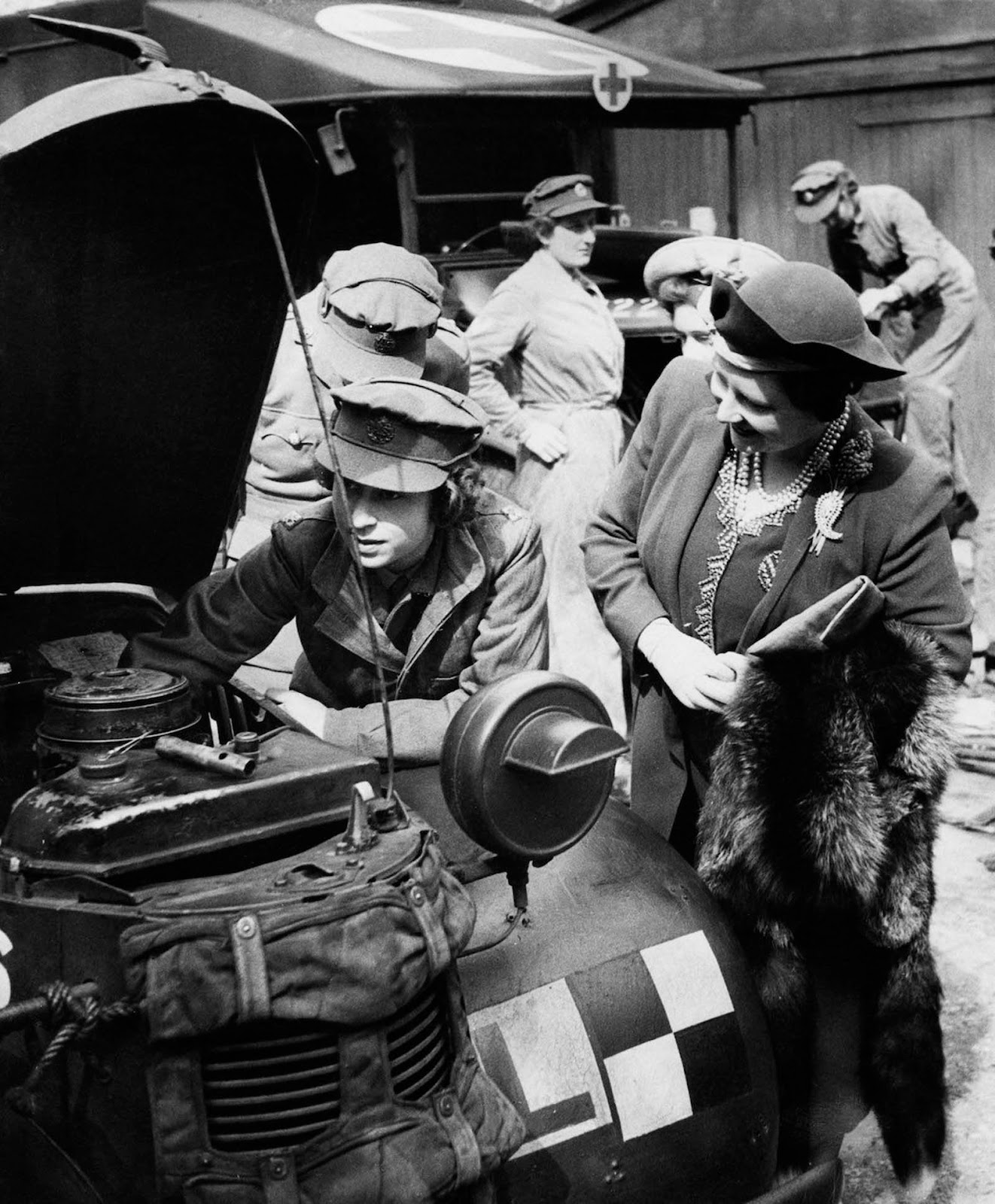 Even the Queen sacrificed more in service to her country than some current world leaders, on both sides of the Atlantic. The Reichstag met for the last time to transfer all power to Adolf Hitler. This action, though mostly an exercise on paper to reflect reality, would doom Germany to destruction by the Allies, as they followed the whims of a vain madman, who was more concerned with personal glory than the health of his nation and ignored all advice of his advisors and experts, even in the face of reason.
|
|
|
|
Post by dbutler69 on Aug 6, 2020 10:47:48 GMT -5
All-Star Squadron #32Roy continues to create a sort of prequel (and names it as such, in this issues title) to Len Wein's JLA story, which introduced the Freedom Fighters. Perosnally, I kind of preferred the idea that they and the rest of the Quality characters were home-grown. Same with the Marvel Family and other Fawcett heroes on Earth-S. Roy wants to play with all of his favorites and bends continuity to fit his needs and had enough carte blanche with DC editorial to do it. I agree with you that it was better to have the Freedom Fighters be home grown earth-X'ers, and apparently Roy Thomas now agrees. In an interview from maybe 10 or so years ago (I think) Roy said that if had had to do it all over again, he'd probably have left the Quality characters out of it. One of the main reasons he added them is because he wanted to use a couple of characters, especially Phantom Lady in order to add another female to the Squadron, but then he wound up not using her anyway (maybe because she didn’t have that much in the way of power and maybe she didn’t seem like that much of an addition to the group) so even that was wasted. Even so, I did enjoy this Freedom Fighters story. I also didn't mind the crossover with earth-S at all. At least he kept them native earth-S'ers. |
|